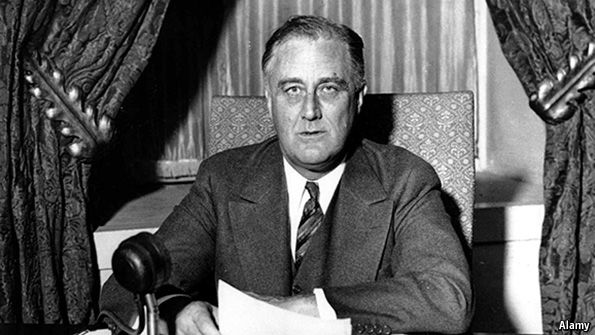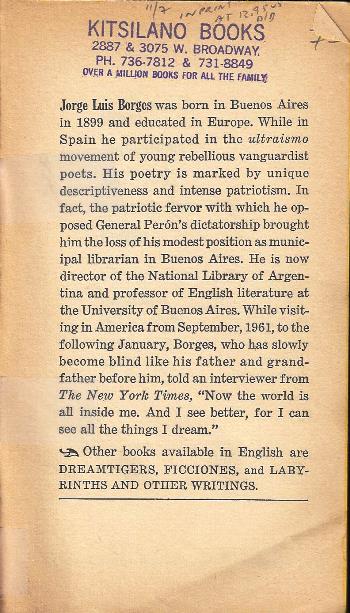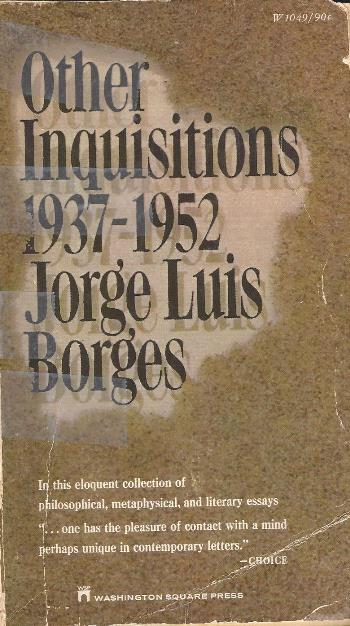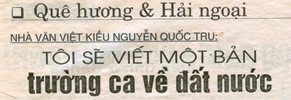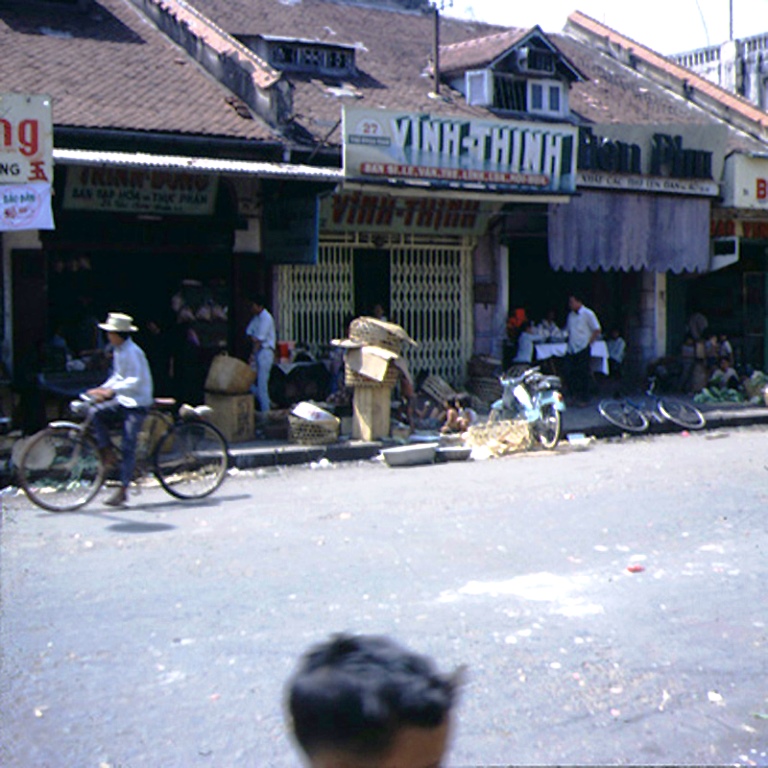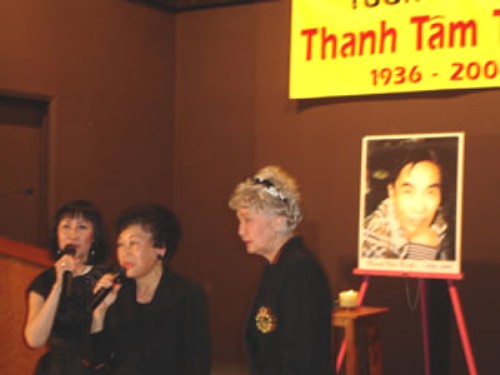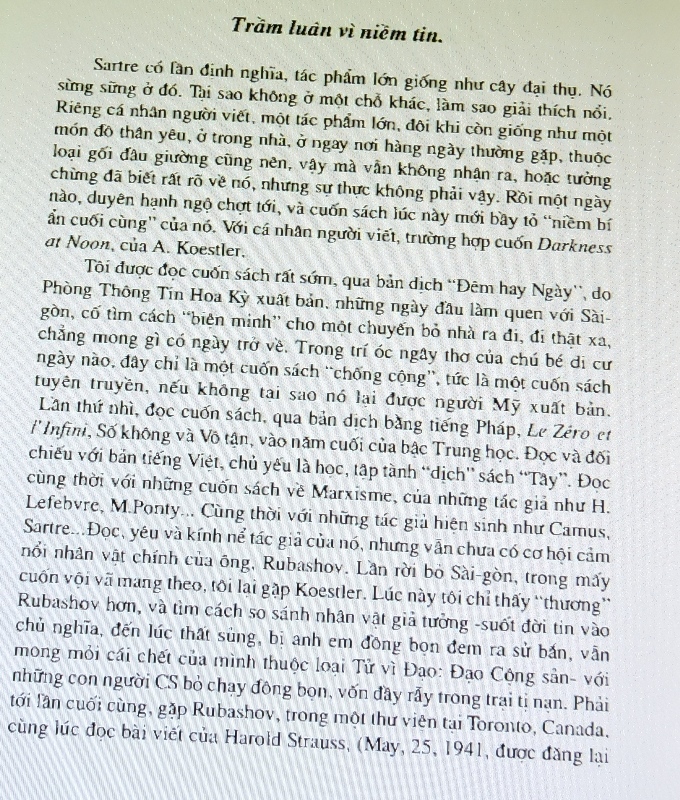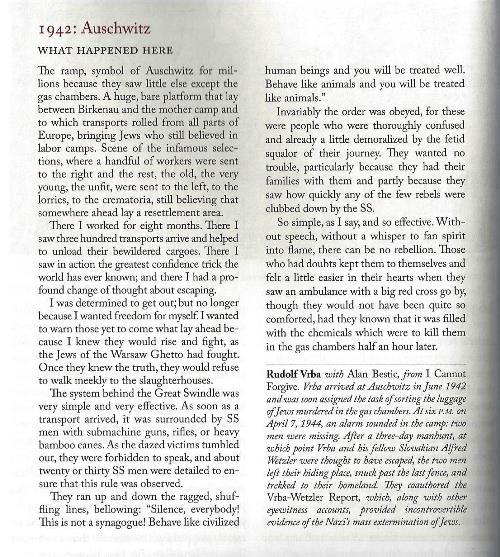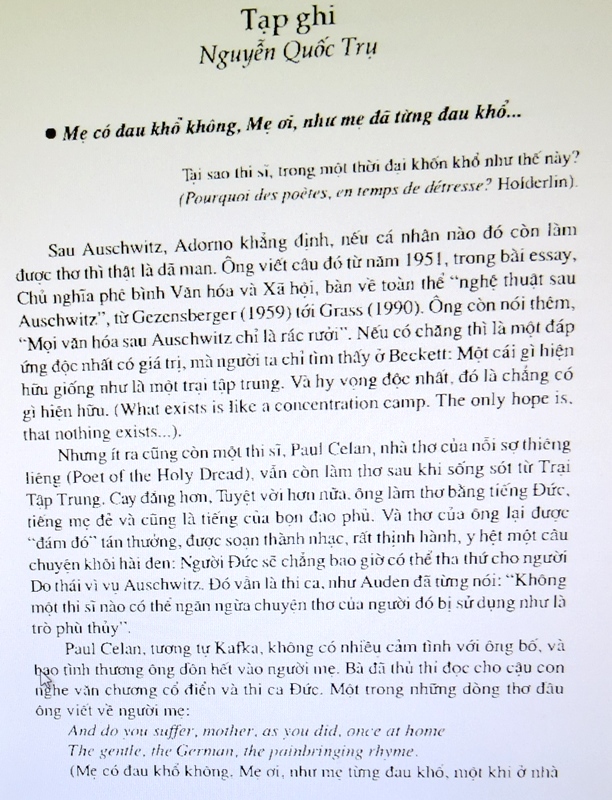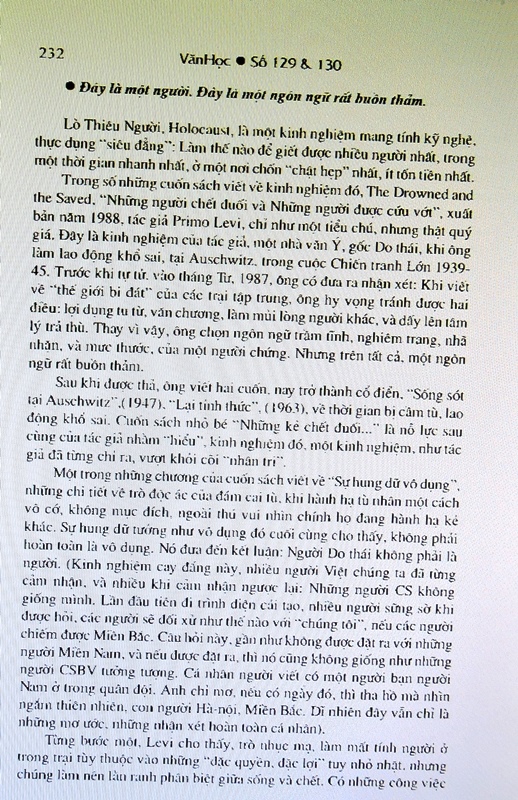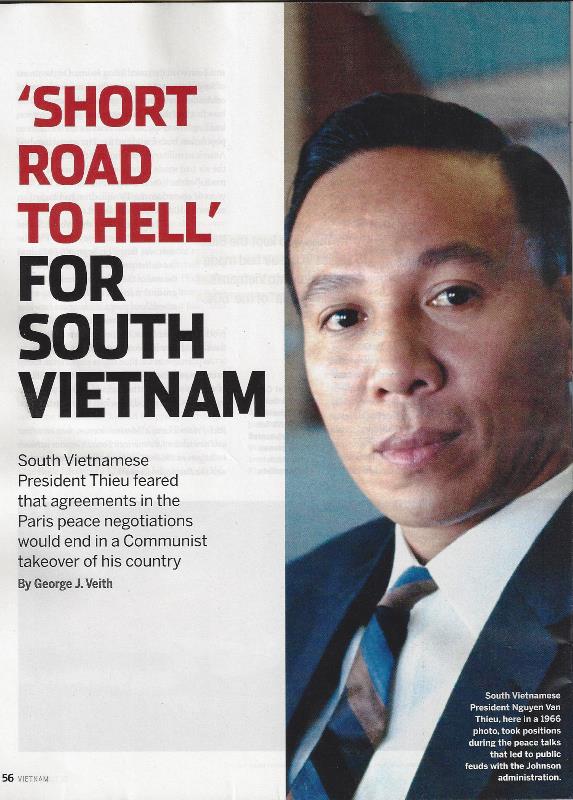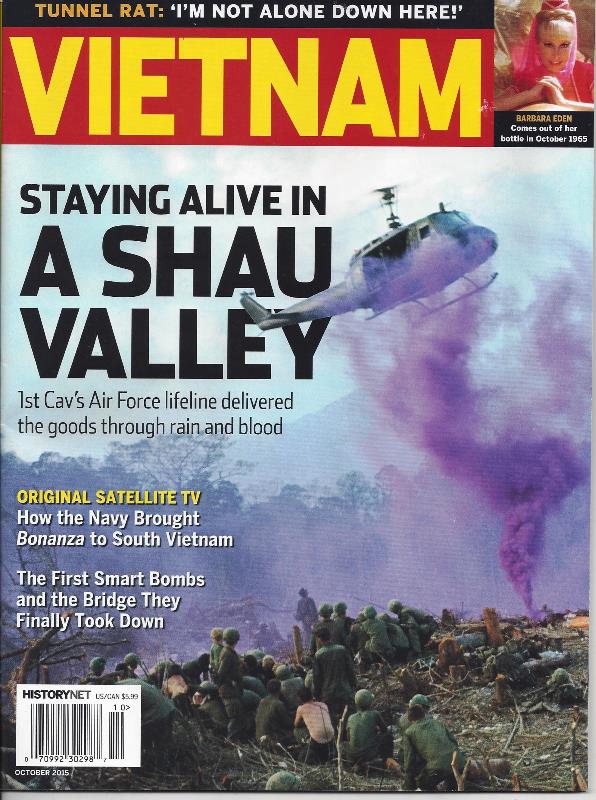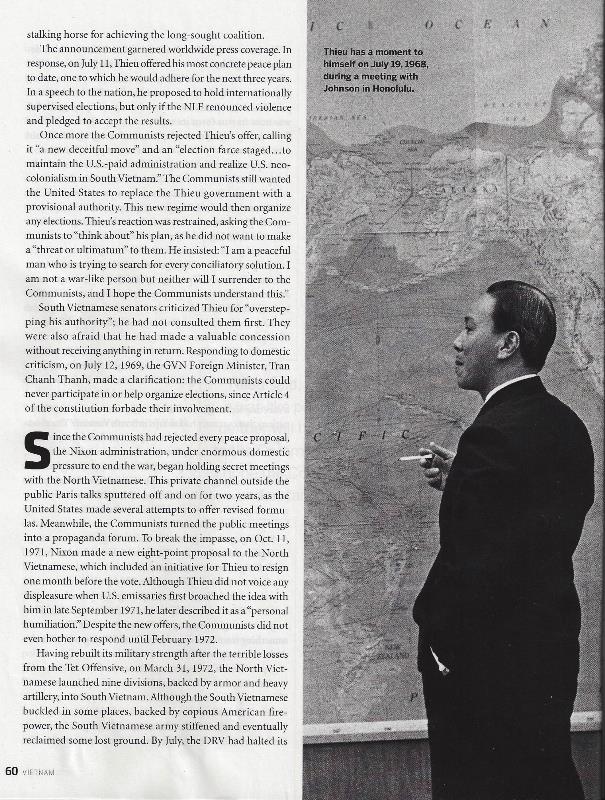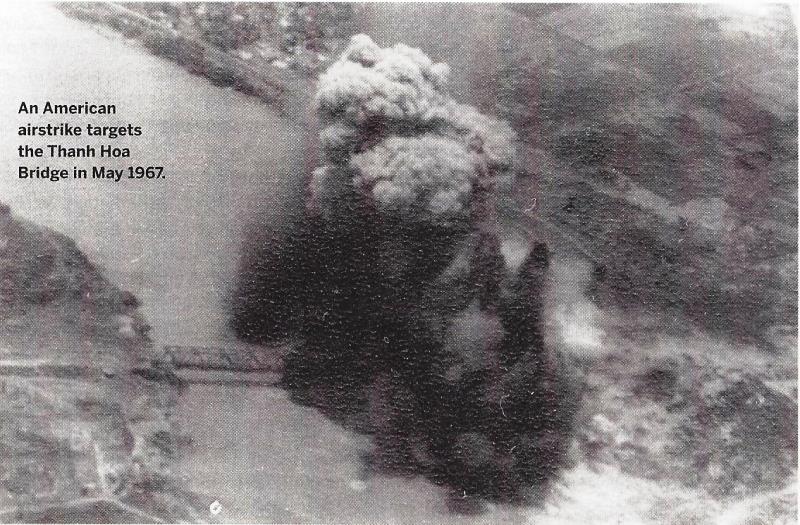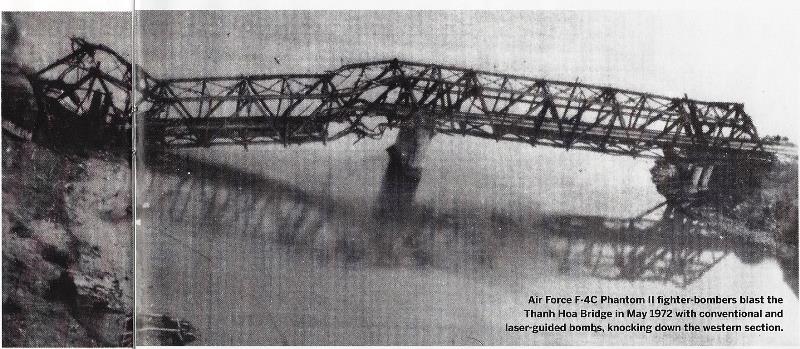|
|
|
Mít vs Lò
Thiêu
Note: Bài viết của Bass, theo GCC, tuyệt.
Nhưng, vì ông không phải là Mít,
và hơn thế nữa, càng không phải 1 tên Bắc Kít, cho nên
ông không thể đẩy nó đến tận cùng, bật ra hai chân lý khổng
lồ về xứ Mít.
Thứ nhất, dân Bắc không hiểu dân chủ
nghĩa là gì, do họ chưa từng biết đến nó. Suốt bốn ngàn
năm dựng nước, hết phong kiến thì nô lệ Tầu, rồi một trăm năm nô lệ thằng Tây, chúng cũng đếch cho
biết mùi dân chủ, mà thay vì vậy, là bảo hộ, với đám cường hào
ác bá dựa oai Tẩy ị lên đầu nhân dân, thi nhau tác quái. Lũ
VC bây giờ, là kế thừa truyền thống đó.
Và chân lý khổng lồ
thứ nhì, ở cái nền của chế độ công an trị, là Cái Ác Bắc Kít.
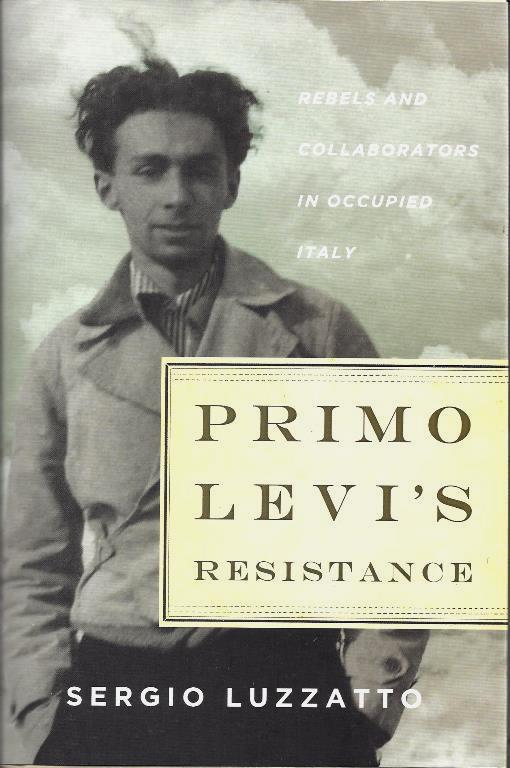 Nguyên tác tiếng Ý 2013.
Bản tiếng Anh, mới ra lò 2016
Nguyên tác tiếng Ý 2013.
Bản tiếng Anh, mới ra lò 2016.
A PIONEERING EXAMINATION OF THE ITALIAN
RESISTANCE
AND THE GRIM SECRET THAT HAUNTED PRIMO
LEVI'S LIFE
No
other Auschwitz survivor has been as literarily powerful and historically
influential as Primo Levi. Yet Levi was not only a victim or a witness.
In the fall of 1943, at the very start of the Italian Resistance, he was
a fighter, participating in the first attempts to launch guerrilla warfare
against occupying Nazi forces. Those three months have been largely overlooked
by Levi's biographers; indeed, they went strikingly unmentioned by Levi
himself. For the rest of his life he barely acknowledged that autumn
in the Alps. But an obscure passage in Levi's The Periodic Table
hints that his deportation to Auschwitz was linked directly to an incident
from that time: "an ugly secret" that had made him give up the struggle,
"extinguishing all will to resist, even to live."
What did Levi -mean by those dramatic lines? His small partisan
band, it appears, had turned on itself, committing a brutal act against
two of its own members. Using that shocking episode as a starting point,
Sergio Luzzatto offers a rich examination of the early days of the
Resistance, when the nascent movement struggled to define its role. Combining
investigative flair with profound empathy, he traces vivid portraits
of both rebels and Nazi collaborators, showing how their fates continued
to be intertwined into the postwar years. And he provides startling
insight into the origins of the moral complexity that runs through the
work of Primo Levi himself.
Lời giới thiệu trang bìa [jacket]
What enemy? Every man's his own
foe,
Each one split by his own
frontier,
Left hand enemy of the right.
Stand up, old enemies of
yourselves,
This war of ours is never
done.
One cannot read that last verse without
thinking of the moment in The Truce when Levi, having just left Auschwitz,
hears words of warning from another of the saved: guerra è sempre,
"war is always." The poem, written almost forty years later, is equally
eloquent and emphatic: the enemy is not outside, but inside the band
of comrades-indeed, inside each one of them. "Every man's his own foe,
/ Each one split by his own frontier."
It would be reassuring to think that in war the enemy
is always outside, and that once the enemy is defeated the problem
of wrongdoing has been resolved. On close inspection, however, the Italian
civil war (where it doesn't seem difficult, at least in retrospect, to
distinguish the side of rights and humanity from the side of inhumanity
and abuse) tells another story. It is a story of unquestionable good,
the fight against Nazi Fascism, intermixed with a story of profound wrong,
a wrong no human being, not even the best, can say he is totally free
of. Between black and white lie many shades of gray. At times this story
is one of simple, sharp contrasts. More often, its truths are expressed
in gradations.
Prologue
Còn lại
một việc nữa: văn chương miền Nam đâu có dừng lại ở năm 1975.
Đây mới là điều huyền bí nhất.
Blog
NL
Nếu như thế, thì cuộc chiến
cũng không chấm dứt với ngày đó.
Trong lời Prologue, trích
đoạn, trên, cho thấy, Primo Levi cũng không tin cuộc chiến Nazi chấm
dứt với cú Đồng Minh giải phóng nước Ý của ông.
War is always.
Cái trò bầu bán Đại Hụi Bịp vừa
xẩy ra mà không mặt dầy, trơ trẽn ư?
Chỉ cần 1 tên Bắc Kít, có tí tiếng tăm, thí dụ như 1 tên Nobel
Toán, viết trên FB, tao nói, đéo được, là sẽ có phản ứng.
Một người thôi ư? Đúng như thế. Một ông Solz đã từng làm. Một ông
Brodsky cũng đã từng.
Cái vụ anh y tá dạo bị Bắc Kít đá đít, thì cũng đã xẩy ra rồi,
với tên Hồ Tôn Hiến, Sáu Dân cái con mẹ gì đó.
Hình như bị đá đít rồi mà còn lăm le làm chuyện ruồi bu, thế là
chúng thịt luôn.
Bạn đọc TV có thể vặc Gấu, nè, nếu mi viết như thế, thì trường
hợp DTH, sao?
Căng, nhể!
Trọng Lú dưới cái nhìn của Người
Kinh Tế qua Đại Hụi Bịp: Trò
ma nớp của loài bò sát
Chính trị xứ Mít
VC
Politics in Vietnam
Reptilian manoeuvres
Trò ma nớp của loài bò sát
A colourful prime minister goes, as the grey men stay
Một vì thủ tướng màu mè ra đi, một lũ muối tiêu ở lại
Note:
Bảnh thật, đám lề trái cũng không nghĩ ra nổi, hình ảnh 1 lũ bò sát ở
Đại Hội Bịp, và cái chết của vị đại cha già dân tộc, là con rùa vàng, biểu
tượng của bốn ngàn năm
văn minh Sông Hồng, nằm chết lều bều trên mặt Hồ Gươm!

Carry on, Nguyen Phu TrongWHEN Great Grandfather,
a revered turtle which had long paddled around Hanoi’s central lake, was
found dead on the eve of the Communist Party’s five-yearly congress, many
Vietnamese thought it a bad omen for the ruling party. The animal embodied
a legend about a 15th-century Vietnamese warrior who presented his sword
to a turtle after vanquishing the Chinese. Some wondered whether the party’s
leaders, whose dusty Marxism-Leninism feels increasingly out of step with
Vietnam’s youthful population of 93m, were also losing their edge.
As it happens, the
congress, which concluded in pomp on January 28th, ended up backing an only
slightly more sprightly reptile. After eight days of unusually fierce politicking,
party bigwigs forced the charismatic and pro-business prime minister to
leave government after his term expires in a few months. Nguyen Tan Dung
had hoped to assume the top party post of general secretary. Instead Mr
Dung, along with the state president, Truong Tan Sang, failed to get a seat
on the party’s new Central Committee, while the septuagenarian incumbent,
Nguyen Phu Trong, was asked to carry on as all-important party chief.
Given term limits
and mandatory retirement ages, Mr Dung, who is 66, had every reason to be
shown the door. Yet analysts thought he might win promotion to general secretary.
His patronage network is extensive, and he enjoyed the support of business
types backing a more open economy. Younger Vietnamese liked Mr Dung’s friendly
stance towards America and his robust defence of Vietnam’s sovereignty
in territorial disputes with China.
True, whiffs of
corruption hung over him, and the bankruptcies of two state firms he championed
were a blot. But many Vietnamese could accept these things. Despite the
scandals, “he still improved Vietnam’s relations with America”, says Pham
Khac Quang, a 33-year-old machine-parts distributor in Hanoi. Had he kept
on doing that, all else “would have been forgiven”. In December Mr Dung defended
his record in a nine-page memo to colleagues, later leaked to a political
blog.
In the end an opposing
party faction loosely grouped around Mr Trong gained the upper hand, in
part through skilful management of voting procedures that baffle even some
insiders. This group appears to have emphasised Mr Dung’s economic mishaps.
His opponents almost certainly pointed out that his self-promotion and his
anti-China populism were incompatible with the Communists’ preference for
cautious, consensual rule. Some doubtless worried that his rise would undermine
their own power.
As for Mr Trong,
party chief since 2011, he is a colourless apparatchik in the twilight of
his career. His support owes as much to Mr Dung’s divisiveness as to any
personal merits; indeed, with the prime minister out of the picture Mr
Trong may soon retire himself, to be replaced by a bland successor—a front-runner
is the party’s propaganda chief, Dinh The Huynh. More interesting are the
officials the congress appears to have chosen for other top jobs. Nguyen
Thi Kim Ngan looks likely to become the first woman to chair the National
Assembly; she understands economics and is broadly well-regarded. The probable
new state president is Tran Dai Quang, the minister for public security.
He would be a worrying choice, given the state’s tendency to lock up and
occasionally torture dissidents. Human Rights Watch calls its record “dismal”.
The next prime minister
is expected to be Nguyen Xuan Phuc, who is harder to read. As one of Mr
Dung’s deputies he has worked to cut red tape, with the help of some American
funding. A foreign businessman calls him a “straight shooter”. Yet Mr Phuc
has demonstrated little of Mr Dung’s popularity or vim, and he probably
cleaves closer to Mr Trong’s slightly more conservative views.
The new leaders
may slow the pace of economic liberalisation, but they are unlikely to reverse
it. Nor will relations with America be set back. It was Mr Trong, after
all, who delighted in calling on President Barack Obama in Washington last
summer—a big step in attempts to make Vietnam less vulnerable to Chinese
bullying. A party plenum recently reaffirmed its support for the Trans-Pacific
Partnership, an American-led trade deal which the incoming government will
soon have to ratify. Meanwhile, bigwigs at the congress made encouraging
noises about shrinking flabby state firms. Investors will welcome this sense
of consistency, although the prime minister’s imminent departure has also
dashed hopes that grander modernisations might be on the cards.
More radical changes
may have to wait for the next congress, in 2021. Then a mass of Russian-speaking
party members, brought up hating America, are due to retire. Their successors
may well be Western-educated technocrats who understand that the party’s
best hope of survival lies in making the economy more competitive, and in
convincing young Vietnamese such as Mr Quang, the machine-parts distributor,
that it has their interests at heart. For the moment, though, hammer-and-sickle
banners cover the capital. And most people—like subjects in a 15th-century
kingdom—have no say in who rules the roost.
Tìm đọc lại bài này thấy hay quá, copy nguyên văn ra đây
cho ai không vượt tường lửa được... Bài này ai là đảng viên cộng sản thì
nên đọc, ai hiểu cộng sản rồi thì có thể bỏ qua... #DMCS
Một thời lịch sử với Nguyễn Hộ
Chia rẽ về tư tưởng trong hàng ngũ những người cộng
sản sau 1975 đã đưa đến sự ly khai hơn 10 năm sau đó của ông Nguyễn
Hộ, một nhà cách mạng kỳ cựu của miền Nam Việt Nam.
... Continue Reading
Nhắc lại giai đoạn từ bỏ con đường cộng
sản của ông Nguyễn Hộ cuối những năm 1980.
Note: CLB Khiến Chán của đám Miền Nam, đã từng được Xịa phịa ra, trong
thời kỳ chiến tranh.
Cũng hội họp, ra mắt, tuyên bố ly khai với VC Bắc Kít. Tẩy mắc bẫy.
Tờ Le Monde đi trang nhất. Tờ Time, chắc là nhờ Cao Bồi, không. Nhưng lộng
giả thành chân. Sau 1975, quả có, với Nguyễn Hộ. Với VC, chống nó là nó thịt,
đơn giản có vậy
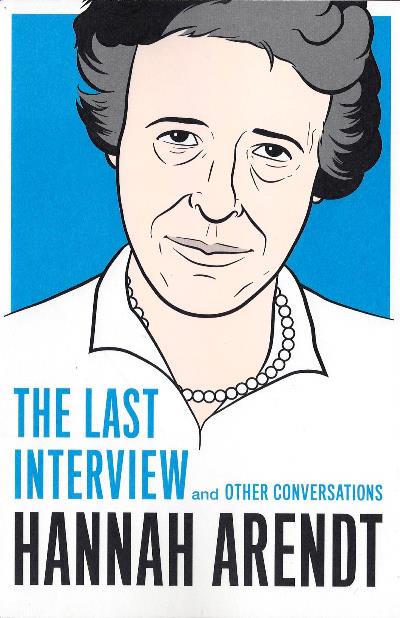
Hannah Arendt, theo GCC là người có thẩm
quyền nhất, theo nghĩa, rất rành, về chủ nghĩa toàn trị.
Hannah Arendt, trong cuốn Từ Dối Trá đến Bạo Lực, chương
Về Bạo Lực, Sur la Violence,
có đưa ra 1 nhận xét, thật tuyệt, nếu áp dụng vào cái cảnh
VC đánh chủ của VC, là nhân dân, như đang xẩy ra.
Bà viết:
Bạo lực càng trở nên
một khí cụ đáng ngờ và không đi đến đâu trong những liên hệ quốc
tế, thì nó lại càng trở nên thật quyến rũ, và thật hữu hiệu ở bên
trong cái gọi là cách mạng…
Marx không phải không
ý thức đến bạo lực trong lịch sử, nhưng ông chỉ ban cho nó 1 vai
trò thứ yếu, cái xã hội cũ đi đến mất tiêu thì không phải do bạo lực
mà là do những mâu thuẫn nội tại… cái gọi là “chuyên chính vô
sản” chỉ có thể được dựng lên sau Cách Mạng và chỉ trong 1 thời
kỳ ngắn…
Plus la violence est devenue
un instrument douteux et incertain dans les relations internationales,
plus elle a paru attirante et efficace sur le plan intérieur,
et particulièreement dans le domaine de la révolution. La rude
phraséologie marxiste de la Nouvelle Gauche s'accompagne des progrès
incessants de la conception non marxiste proclamée par Mao Tsé-toung,
selon laquelle « le pouvoir est au bout du fusil ». Certes, Marx
était parfaitement consscient du rôle de la violence dans l'histoire,
mais ce rôle lui paraissait secondaire; la société ancienne est conduite
à sa perte non par la violence, mais par ses contradictions internes.
L'apparition d'un nouveau type de société est précédée, mais
non provoquée, de convulsions violentes qu'il compare aux douleurs
de l'enfantement qui précèèdent la naissance, mais qui, naturellement,
n'en sont pas la cause. Dans la même ligne de pensée, il estimait
que l'Etat constituait un instrument de violence au service de la classe
dominante, mais cette classe n'exerce pas son pouuvoir en ayant recours
aux moyens de la violence. Il réside dans le rôle de la classe dirigeante
dans la société, ou, plus exactement, dans le processus de production.
On a souvent remarqué, et parfois déploré, que, sous l'influence
des théories de Marx, la gauche révolutionnaire se refusait à utiliser
les moyens de la violence; la« dictature du prolétariat» qui,
selon Marx, devait être ouvertement répressive, ne devait être instaurée
qu'après la Révolution, et ne durer, comme la dictature romaine, qu'une
période de temps limitée; l'assassinat politique, à l'exception de quelques
actes de terrorisme individuel accomplis par de petits groupes d'anarchistes,
fut surtout utilisé par la droite, tandis que les soulèvements armés
et organisés demeuraient principalement une prérogative militaire. La
gauche restait néanmoins convaincue que « toutes les conspirations
sont non seulement inutiles mais nuisibles. Elle [savait] trop bien que
les révolutions ne se font pas d'une façon intentionnelle et arbitraire,
mais qu'elles sont partout et toujours le résultat nécessaire de circonstances
entièrement indépendantes de la volonté et de la direction des partis
et de classes entières de la société.»
Hannah Arendt: Sur
la violence
Hannah Arendt :
Những Nguồn Gốc Của Chủ Nghĩa Toàn Trị.
Lời Tựa lần xuất bản đầu (1951).
Thực vậy, đây là nỗi khốn khó của thời
đại chúng ta, mắc míu lung tung, đan xen lạ lùng giữa xấu và tốt, đến
nỗi, nếu không có "bành trướng để bành trướng" của những tên đế quốc,
thế giới chẳng bao giờ trở thành một; nếu không có biện pháp chính
trị "quyền lực chỉ vì quyền lực" của đám tư sản, cái sức mạnh vô biên
của con người chắc gì đã được khám phá; nếu không có thế giới ảo vọng,
thiên đường mù của những phong trào toàn trị, qua đó, những bất định thiết
yếu của thời đại chúng ta đã được bầy ra một cách thật rõ nét, như chưa
từng được bầy ra như vậy, thì làm sao chúng ta [lại có cơ hội] bị đẩy tới
mấp mé bên bờ tận thế, vậy mà vẫn không hay, chuyện gì đang xẩy ra?
Và nếu thực, là, trong những giai đoạn tối hậu của chủ nghĩa
toàn trị, một cái ác triệt để xuất hiện, (triệt để bởi vì chúng không
thể suy diễn ra, từ những động cơ có thể hiểu được, của con người), thì
cũng thực, là, nếu không có chủ nghĩa toàn trị, chúng ta có thể chẳng
bao giờ biết được bản chất thực sự cơ bản, thực sự cội rễ, của cái ác.
Chủ nghĩa bài Do Thái (không phải chỉ có sự hận thù người
Do Thái không thôi), chủ nghĩa đế quốc (không chỉ là chinh phục), chủ
nghĩa toàn trị (không chỉ là độc tài) – cái này tiếp theo cái khác,
cái này bạo tàn hơn cái kia, tất cả đã minh chứng rằng, phẩm giá của
con người đòi hỏi một sự đảm bảo mới, và sự đảm bảo mới mẻ này, chỉ có
thể tìm thấy bằng một nguyên lý chính trị mới, bằng một lề luật mới
trên trái đất này; sự hiệu lực của nó, lần này, phải được bao gồm
cho toàn thể loài người, trong khi quyền năng của nó phải được hạn chế
hết sức nghiêm ngặt, phải được bắt rễ, và được kiểm soát do những thực
thể lãnh thổ được phân định mới mẻ lại.
Chúng ta không còn có thể cho phép chúng ta giữ lại những
cái gì tốt trong quá khứ, và đơn giản gọi đó là di sản của chúng ta,
hay loại bỏ cái gì là xấu, giản dị coi đó là một gánh nặng chết tiệt mà
tự thân chúng sẽ bị thời gian chôn vùi trong lãng quên. Cái mạch ngầm
của lịch sử Tây phương sau cùng đã trồi lên trên mặt đất, và soán đoạt
phẩm giá của truyền thống của chúng ta. Đây là thực tại chúng ta
sống trong đó. Đây là lý do tại sao mọi cố gắng chạy trốn cái u ám
của hiện tại, bằng hoài vọng một quá khứ vẫn còn trinh nguyên, hay bằng
một sự lãng quên có dự tính về một tương lai tốt đẹp hơn: tất cả những
cố gắng như vậy đều là vô hiệu.
không một tờ báo nào đăng tin linh mục
Chân Tín qua đời. đấy là vị Chủ tịch ủy ban cải thiện chế
độ lao tù miền Nam Việt Nam.Người công bố cho thế giới biết
chế độ chuồng cọp Côn Đảo đã vi phạm nhân quyền như thế nào.
Lịch sử để lịch sử phán xét,
người trí thức chế độ nào cũng vậy nếu vi phạm quyền
con người thì họ lên tiếng.
tôi khinh bọn ăn cháo đá
bát của ngày xưa nếu không có linh mục Chân Tín
, Linh mục Nguyễn Ngọc Lan các ông đã rũ xương trong tù, nay
các ông [ trừ người đã chết ] ăn cháo đá bát.
Thưa người tôi xem là thầy đang
ở nước ngoài và các anh em. tôi không hoàn tất
được việc thầy nhờ để tên trong việc cậy nhờ chia buồn. vì
không báo nào chịu đăng dù tôi sẵn sàng trả đăng tin tiền
sòng phẳng
kwan
RIP
Đây là 1 phần của cái giá
phải trả của đám được coi là Lực Lượng Thứ Ba, tức đám
nằm vùng.
Tất cả đám này, số phận tên
nào cũng thế, than thở cái nỗi gì nữa.
NQT
V/v “ăn cháo đá bát”. Câu này còn có khi được hiểu/viết là,
“ăn cháo đái bát”, và cái nghĩa này, mới đúng, cho 1 số tên nằm
vùng bợ đít VC, trong có tên “người của chúng ta ở Paris”.
GCC đã từng viết về tên này đôi lần rồi, viết thêm, có khi
chúng lại nghĩ Gấu thù oán cá nhân.
Tất nhiên, không, vì thú thực, Gấu không có được cái thú
vui độc ác bịnh hoạn này, tiếc thế, nhưng cái cas của tên này quá quái
đản, thưộc loại siêu, nên đành lại lôi ra. (1)
Cũng Bắc Kít di cư, cũng dân Chu Văn An, bố còn làm giám
thị, cùng học một năm với Gấu, khác lớp, nổi tiếng giỏi toán, được Ngụy
cho đi du học, nằm vùng VC, đã từng làm tà lọt/thông ngôn cho trưởng
phái đoàn Bắc Kít ở hòa đàm Paris….
Những sự kiện đó, cũng thường, vì hắn tin vào chủ nghĩa,
tin vào lý tưởng nước Mít là một, vv và vv.
Nhưng có chuyện này, Gấu không làm sao hiểu nổi. Đó là hắn
cạy miệng người đã chết, để nhét vô miệng những lời nói cực kỳ thô bỉ.
Người này là bố của 1 ông, bạn của hắn. Cũng 1 tên tuổi
trong giới giang hồ, đã từng làm Trùm chương trình tiếng Mít của Đài
Bi Bi Xèo. Ông bố là Ngụy, đi tù VC về, ông con hỏi, tù ra sao, thì tất
nhiên là khổ rồi, đáy địa ngục mà, nhưng giả như ta [Ngụy] mà thắng, thì
khủng khiếp hơn nhiều!
Khủng khiếp hơn nhiều, như thế nào, thì hắn không cho biết,
mà chỉ cho biết, ông bố nói xong, gạt phắt, thôi đừng hỏi chuyện đó
nữa, cái gì đã qua, cho qua luôn!
Cùng học môt năm, hình như thế. Những gì về tên này, Gấu
biết được, là qua 1 anh bạn cùng học.
Đệ tử của Cao Bồi. Bị Xịa gài, trong vụ "một ngàn giọt lệ".
Tuy công lao như thế, vậy mà bị Vẹm cấm cửa, không cho về. Ông chánh
tổng An Nam ở Paris cũng đã từng bị Vẹm cấm cửa!
Được, được!
Cái này thì đành phải khen Vẹm 1 phát!
Gấu là thằng viết lách đầu tiên, dám về trong nước, và được
Vẹm đón tiếp rất ư là niềm nở, thú thế chứ, chúng đâu so được với Gấu!
(1)
Bạn có thể cắt nghĩa, cái sự GCC hay lèm bèm về Cái Ác
Bắc Kít, theo cái cảm tính của Kafka, với Prague của ông:
Trong 1 lá thư cho
bạn, Kafka viết, luần quần trong bất cứ 1 ai, là một con quỉ, nó
gậm đêm, đến tang thương, đến hủy hoại, và điều này, đếch VC, và cũng
đếch Ngụy, hay đúng hơn, đời Mít là như thế:
Nếu bạn đếch phải như thế, thì bạn đếch phải là Mít!
Bạn không thể sống, đúng hơn.
Kafka Poet
Cu Bao
with Bùi Văn Phú
and 18 others.
Đối kháng quyền lực
Vậy là trong vòng 2 năm nữa tôi sẽ bị giam lỏng ở đây.
Tôi không thể chống lại chuyện này vì Nhà nước có công an, quân đội
và nhà tù. Tôi ch...
See
More
Đọc, tên "người của chúng ta ở Paris",
cậy miệng xác chết để nhét lời thô bỉ, đã tởm, nhìn tên này tự sướng,
tởm cũng chẳng thua!
Gấu đã nói rồi, lũ này, mỗi tên tởm một kiểu.
Suốt đời phản kháng!
Có lần Gấu phán, VNCH,
hay Ngụy, có lẽ là chế độ đẹp nhất mà xứ Mít có được, và sau này, không
thể nào lại có được, và sở dĩ được như thế, phần lớn, là nhờ cái nền
của nó, là 1 Miền Nam thiên hòa địa lợi, trọng nhân bằng, nhân ái, chưa
từng biết đến cái ác, cái đói, cái khổ, khác hẳn Miền Bắc. Cuộc chiến
Mít, họ đâu có muốn, và hơn thế nữa, họ đâu có hận thù Miền Bắc. Bầu cử
dân chủ như Miến Điện bây giờ? Cái đó, dân Miền Nam đã hưởng rồi. Họ chọn
người họ thích, tin tưởng, trọng nể vô Thượng Viện, Hạ Viện. Lũ nằm vùng,
rồi Bắc Kít, tìm đủ mọi cách làm thịt nó, kết quả là 1 nước Mít như bây
giờ, lũ khốn này phạm vào tội đại ác, vậy mà bây giờ tự sướng, tụ thổi
bằng những dòng cực tởm. Suốt đời phản kháng? Kít
Trang
Top Ten, trong tháng:
Tình cờ lục lọi báo cũ, GCC lôi ra 1 tờ NYRB,
Dec 20, 2001, trong có lá thư của 1 độc giả, hỏi, nhân 1 bài trước đó,
giả như không có Lenin, thì không có chủ nghĩa CS? Tác giả bài viết “Lenin
& The Radiant Future”, trả lời, khó lắm, vì còn nhiều yếu tố khác,
trong có Marx, và những bài giảng của ông này thì đầy quyền uy, vì thực
[Marx’s teaching is all-powerful because it is true]
[Bỗng như nghe Vương Tân, phán, Vượt Mác, dễ ợt!]
Đem câu hỏi đó vô xứ Mít, liệu Bác Hồ, khi làm bồi tầu, rửa chén
không sạch, bị đại bàng, đầu gấu đánh chết, thì liệu xứ Mít thoát nạn
VC?
Căng, nhể?
Theo GCC, cái chết của xứ Mít, là từ mắc míu ngàn đời, từ thuở
lập nước, với Tẫu. Một mặt chống Tẫu, 1 mặt mở nước về phiá Nam, lịch sử
Mít cứ thế kéo dài, cho đến lúc Bác Hồ làm bồi Tây, rồi qua Tây, vô Đảng
CS Tây, lấy tên Tây, vưỡn OK như thường.
Chỉ đến khi Bác trốn Tẩy đi Moscow, rồi được Moscow phái về TQ,
là kể như số phận xứ Mít ô hô ai tai!
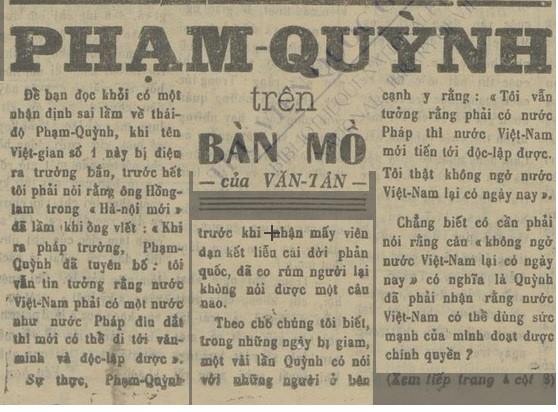
Phạm Quỳnh, vào giây phút
cuối cùng của đời mình, trước khi bị Vẹm làm thịt - trong lúc
đó, Bác Hồ đang bận viết cái thư gửi cho mấy chú Phạm Tuân, con Phạm
Quỳnh, ngày sau lịch sử sẽ minh oan cho cha của các chú - vẫn tin rằng,
phải có thằng Tẩy dìu dắt thì xứ Mít mới khá được.
Graham Greene cũng tin như thế, khi đi những dòng
hoài nhớ chủ nghĩa thực dân thuộc địa của Tẩy ở xứ An Nam ta.
Nhưng những cảm khái trên đây, chỉ có tính
cảm khái. Bây giờ nhìn lại, chúng mang ý nghĩa lịch sử. Vẹm đánh
Tây, là để làm thịt Việt Gian. Đánh Mẽo, để tranh chân làm bồi
Mẽo của Ngụy!
Greene provided surprising support for colonialism,
suggesting the relativity of his political beliefs. Elsewhere he
wrote: 'the writer should always be ready to change sides at the drop
of a hat. He stands for the victims, and the victims change?
In an article for Paris Match he took a more Olympian
view:
It is a stern and sad outlook and, when everything
is considered, it represents for France the end of an empire. The
United States is exaggeratedly distrustful of empires, but we Europeans
retain the memory of what we owe to Rome, just as Latin America knows
what it owes to Spain. When the hour of evacuation sounds there will
be many Vietnamese who will regret the loss of the language which put
them in contact with the art and faith of the West. The injustices committed
by men who were harassed, exhausted and ignorant will be forgotten
and the names of a good number of Frenchmen, priests, soldiers and
administrators, will remain engraved in the memory of the Vietnamese:
a fort, a road intersection, a dilapidated church. 'Do you remember,'
someone will say, 'the days before the Legions left?'
Cái câu cảm khái của Phạm Quỳnh, "không ngờ xứ
Mít khốn nạn như ngày hôm nay", thì cũng giống như quyết định, của
ông cụ của Gấu, không muốn đám con cái của ông sau này, bị nỗi nhục
nhã, bố mày là 1 tên Vẹm.
TTT cũng có ý đó, khi viết:
Chúng nó
say giết người như gạch ngói
Như lòng chúng ta thèm khát tương lai
Cái tương lai của dân Mít, có vẻ như bây giờ mới
ló dạng.
Hãy cho anh khóc bằng mắt em
Những cuộc tình duyên Budapest
Hãy cho anh khóc bằng mắt em
Những cuộc tình duyên Budapest
Anh một trái tim em một trái tim
Chúng kéo đầy đường chiến xa đại bác
Hãy
cho anh giận bằng ngực em
Như chúng bắn lửa thép vào
Môi son họng súng
Mỗi ngã tư mặt anh là hàng rào
Hãy
cho anh la bằng cổ em
Trời mai bay rực rỡ
Chúng
nó say giết người như gạch ngói
Như lòng chúng ta thèm khát tương lai
Hãy
cho anh run bằng má em
Khi chúng đóng mọi đường biên giới
Lùa
những ngón tay vào nhau
Thân thể anh chờ đợi
Hãy
cho anh ngủ bằng trán em
Ðau dấu đạn
Ðêm
không bao giờ không bao giờ đêm
Chúng tấn công hoài những buổi sáng
Hãy
cho anh chết bằng da em
Trong dây xích chiến xa tội nghiệp
Anh sẽ sống
bằng hơi thở em
Hỡi những người kế tiếp
Hãy cho
anh khóc bằng mắt em
Những cuộc tình duyên Budapest
12-56
Let the Past Collapse on Time!
“Dzhugashvili [Stalin] is there,
preserved in a jar,” as the poet Joseph Brodsky wrote
in 1968. This jar is the people’s memory, its collective
unconscious.
“Stalin ở trong đó, được gìn giữ ở trong
1 lọ sành”, như Brodsky viết, vào năm 1968. Cái lọ sành là
hồi ức của dân tộc, cái vô thức tập thể của nó.
“Tẫu Cút Đi”: Trong cái
lọ sành đựng hồi ức của Bắc Kít, hình như đếch có
chỗ dành cho Tẫu, trong cả hai cuộc chiến thần kỳ, chống thực dân
cũ, Pháp, và mới, Mẽo.
“You were not
who you were, but what you were rationed to be”:
Mi không phải là mi, mà là kẻ được
cái chế độ tem phiếu đó nắn khuôn.
Yiyun Li
Cái chuyện Miền Nam, tức Ngụy, chống Tẫu,
thì rõ như ban ngày.
Còn cái chuyện Bắc Kít chống Tẫu,
thì có cái gì đó cực kỳ vô ơn ở trong đó
Không có Tẫu, là cả hai cuộc chiến
không có.
Nhìn rộng ra, nhìn suốt 1 cõi 4 ngàn
năm văn hiến của.. Bắc Kít, có hai yếu tố không có, lòng
nhân từ và lòng biết ơn.
Di chúc Bác Hồ có câu,
ta thà ngửi cứt Tây 5 năm, còn hơn là ngửi cứt Tầu cả
đời. Cái tay viết tiểu sử Graham Greene trích dẫn, nhưng anh ta
thòng thêm 1 câu, Bác nói thì Bác nói, gái Tẫu, Tẫu dâng, Bác
không tha, khí giới Tẫu cung cấp để giết Ngụy, Bác cũng nhận,
gạo Tẫu viện trợ cho Bắc Kít khỏi chết đói, OK hết.
Thu
Ngoc Dinh
Bà Dương Thu Hương, cựu Phó Thống đốc NHNN VN: "Láng giềng
chúng ta sang đây xây dựng làng xã, thành phố rồi!"
Đây là nội dung phát biểu của bà Dương Thu Hương, ...
Thế rồi nhận định nữa là do ‘sự chống phá của các thế lực
thù địch’. Tôi thấy chưa tìm đâu thấy cái chống phá bên ngoài, nhưng
cái niềm tin của dân đã giảm, thì còn nguy hiểm hơn cả thế lực bên ngoài.
Cái điều đó là cái mà tôi cho rằng cần phải đánh giá như thế, chứ còn
ba cái thằng Việt kiều nó về lọ mọ vớ vẩn, không thèm chấp. Tất nhiên
chúng ta vẫn cảnh giác nhưng chưa thấy ai chống phá chúng ta những cái
gì mà gọi là để cho đất nước này đổ cả. Mà tôi chỉ sợ cái lòng dân này
làm cho chúng ta sụp đổ. Nó như là một toà nhà mà bị mối, mặt bên ngoài
toà nhà vẫn rất đẹp nhưng mà nó bị mối hết rồi".
Mời nghe toàn bộ audio tại đây: https://www.youtube.com/watch?v=ubS8pd28Ua0
Note: Bà này bảnh thực.
Tếu nhất, là, cùng tên với nhà văn DTH!
Cùng các anh chị em chạy lên Đồng Nai "giải cứu" Đỗ
Thị Minh Hạnh và Trương Minh Đức ra khỏi đồn công an Long Bình lúc
gần 2 giờ sáng rồi cùng mọi người đưa cả hai về cấp cứu tại bệnh viện
Hoàn Mỹ Sài Gòn, chừ 3 giờ sáng mới về đến nhà. Còn nhiều anh chị em
vẫn ở lại bệnh viện với Đức và Hạnh.
Công an đã đánh Minh Hạnh và Minh Đức bầm dập, Hạnh bị
tổn thương vùng đầu và khắp người đến mức không đi nổi, anh em phải dìu
ra xe.
Chừ đi ngủ mai sẽ kể nhiều chuyện về vụ bắt và đánh người
hung tợn phi pháp nầy của công an Đồng Nai.
Trần Bang,
Tia Chop Nho,
Nguyễn Hoàng
Vi, Tran Nguyen,
Peter Lam Bui,
Hoàng
Dũng, Tuấn Khanh, Suong Quynh...
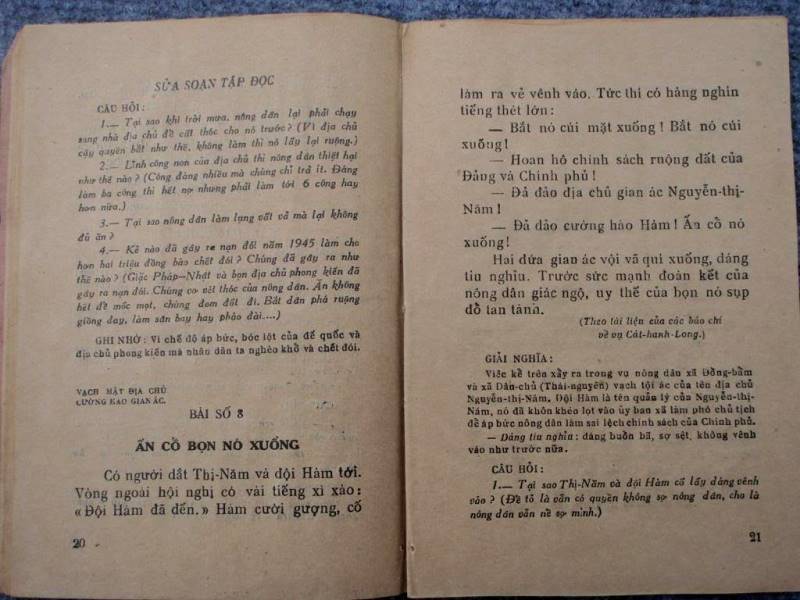
Nguyễn Quang
Duy added 3 new photos
— with Ngô Nhật
Đăng and 85 others.
ĐIỀN CHỦ NGUYỄN THỊ NĂM MỘT NHÂN VẬT LỊCH SỬ.
Nguyễn Quang Duy
Khai mạc cuộc triển lãm Cải cách ruộng đất (CCRĐ), ông
Nguyễn Văn Cường, Giám đốc Bảo tàng Lịch s ...
Borges
cho rằng, quan niệm về một âm mưu ghê rợn của Đức nhằm thống trị toàn
thế giới, là quá tầm phào, cà chớn.
"Gấu Nhà Văn" tin rằng Cái Ác Bắc Kít đưa đất nước
Mít xuống hố; Borges, chính cái thứ giáo dục dậy con nít hận thù gây
đại họa.
TV post mấy
đoạn viết của ông, và sẽ số gắng chuyển ngữ, nếu có thể.
NOTES ON GERMANY & THE WAR
JORGE
LUIS BORGES
A Pedagogy of Hatred
Displays of hatred are even more
obscene and denigrating than exhibitionism. I defy pornographers to show
me a picture more vile than any of the twenty-two illustrations that comprise
the children's book Trau keinem Fuchs auf gruener Heid und keinem Jud
bei seinem Eid [Don't Trust Any Fox from a Heath or Any Jew on his Oath]
whose fourth edition now infests Bavaria.
It was first published a year ago, in 1936, and has already sold 51,000
copies. Its goal is to instill in the children of the Third Reich
a distrust and animosity toward Jews. Verse (we know the mnemonic virtues
of rhyme) and color engravings (we know how effective images are) collaborate
in this veritable textbook of hatred.
Take any page: for example, page
5. Here I find, not without justifiable bewilderment, this didactic
poem-"The German is a proud man who knows how to work and struggle.
Jews detest him because he is so handsome and enterprising" -followed
by an equally informative and explicit quatrain: "Here's the Jew, recognizable
to all, the biggest scoundrel in the whole kingdom. He thinks he's wonderful,
and he's horrible." The engravings are more astute: the German is a Scandinavian,
eighteen-year-old athlete, plainly portrayed as a worker; the Jew is a
dark Turk, obese and middle-aged. Another sophistic feature is that the
German is clean-shaven and the Jew, while bald, is very hairy. (It is well
known that German Jews are Ashkenazim, copper-haired Slavs. In this book
they are presented as dark half-breeds so that they'll appear to be the exact
opposite of the blond beasts. Their attributes also include the permanent
use of a fez, a rolled cigar, and ruby rings.)
Another engraving shows a lecherous dwarf trying to seduce
a young German lady with a necklace. In another, the father reprimands
his daughter for accepting the gifts and promises of Solly Rosenfeld,
who certainly will not make her his wife. Another depicts the foul body
odor and shoddy negligence of Jewish butchers. (How could this be,
with all the precautions they take to make meat kosher?) Another, the
disadvantages of being swindled by a lawyer, who solicits from his
clients a constant flow of flour, fresh eggs, and veal cutlets. After a
year of this, the clients have lost their case but the Jewish lawyer
"weighs two hundred and forty pounds." Yet another depicts the opportune
expulsion of Jewish professors as a relief for the children:
"We want a German teacher;' shout
the enthusiastic pupils, "a joyful teacher who knows how to play with
us and maintain order and discipline. We want a German teacher who will
teach us common sense." It is difficult not to share such aspirations.
What can one say about such a book? Personally I am outraged,
less for Israel's sake than
for Germany's,
less for the offended community than for the offensive nation. I don't
know if the world can do without German civilization, but I do know
that its corruption by the teachings of hatred is a crime.
[1937]
1939
Those who hate Hitler usually
hate Germany...
... I naively believe that a powerful Germany would
not have saddened Novalis or been repudiated by Holderlin. I detest Hitler
precisely because he does not share my faith in German people; he has decided
that to undo 1918, the only possible lesson is barbarism ; the best incentive,
concentration camp....
1941
The notion of an atrocious conspiracy by Germany
to conquer and oppress all the countries of the atlas is (I rush to admit)
irrevocably banal. It seems an invention of Maurice Leblanc, of Mr. Phillips
Oppenheim, or of Baldur von Schirach. Notoriously anachronistic, it has
the unmistakable flavor of 1914. Symptomatic of a poor imagination, grandiosity,
and crass make-believe, this deplorable German fable counts on the complicity
of the oblique Japanese and the docile, untrustworthy Italians, a circumstance
that makes it even more ridiculous ... Unfortunately, reality lacks literary
scruples. All liberties are permitted, even a coincidence with Maurice Leblanc.
As versatile as it is monotonous, reality lacks nothing, not even the purest
indigence. Two centuries after the published ironies of Voltaire and
Swift, our astonished eyes have seen the Eucharist Congress; men fulminated
against by Juvenal rule the destinies of the world. That we are readers
of Russell, Proust, and Henry James matters not; we are in the rudimentary
world of the slave Aesop and cacophonic Marinetti. Ours is a paradoxical
destiny.
Le vrai peut quelque fois n'être pas vraisemblable: the unbelievable, indisputable truth is that the
directors of the Third Reich are procuring a universal empire, the
conquest of the world. I will not enumerate the countries they have
already attacked and plundered, not wishing this page to be infinite.
Yesterday the Germanophiles swore that the maligned Hitler did not
even dream of attacking this continent; now they justify and praise
his latest hostility. They have applauded the invasion of Norway and Greece, the Soviet Republics
and Holland;
who knows what celebrations they will unleash the day our cities and
shores are razed. It is childish to be impatient; Hitler's charity is
ecumenical; in short (if the traitors and Jews don't disrupt him) we
will enjoy all the benefits of torture, sodomy, rape, and mass executions.
Do not our plains abound in Lebensraum, unlimited and precious matter?
Someone, to frustrate our hopes, observes that we are very far away,
My answer to him is that colonies are always far from the metropolis;
the Belgian Congo is not on the borders of Belgium.
BORGES: An Essay on Neutrality
CCRD,
lệnh từ Bắc Kinh, Bắc Kít phải làm, là, phải làm.
Giả như để chậm lại, là không có vụ di cư.
Bắc Kít quên ơn Tẫu, nhưng, có thể nói, không có Tẫu không
có Ngụy. Hoặc có, nhưng chết hết ở trong Lò Cải Tạo, nếu Tẫu không dạy
cho VC hai bài học!
Thực hư môn sử bị 'xóa sổ'?
http://www.bbc.com/vietnamese/vietnam/2015/11/151119_hangout_history_teaching
Cái môn sử mà VC nhồi nhét vô đầu con nít, sở dĩ giờ
này lâm đại họa, vì nó quá nhảm. Làm đếch gì có Lê Văn Tám, thí dụ,
và gần đây nhất, là cuộc chiến Mít: Từ trẻ con tới người lớn xứ Bắc
Kít bây giờ thì mới ngã ngửa ra rằng thì là, hóa ra Ngụy chúng sướng
hơn Cách Mạng nhiều, và rõ ràng là chúng “người” hơn nhiều so với thứ
được trồng bằng Cái Ác Bắc Kít.
Không chỉ sử, mà có thể nói cả 1 nền giáo dục Bắc Kít
cần phải xóa sổ, vì đó là 1 nền giáo dục dậy con nít hận thù.
Cái chết của Bắc Kít, là dậy con nít thù hận.
Borges bị Naipaul chửi là cả đời mân mê cái bất tử,
đếch thèm để ý đến đời thực.
Không đúng. Cả đời Borges, bất cứ khi nào ông quan tâm
đến đời thực, là thực sự quan trọng, hết sức cần thiết.
Ông phán, Lò Thiêu, sở dĩ xẩy ra, là vì nước Đức dậy
con nít thù hận. Cái thù hận sắc dân chỉ là cái cớ, dậy con nít thù
hận mới là cái chết của nước Đức.
Hai phát giác thần sầu của Borges liên quan tới Nazi,
đều có gì mắc mớ tới Bắc Kít, và cuộc chiến vừa qua, theo GCC.
Thứ nhất, là nền giáo dục hận thù gây họa.
Thứ nhì, Borges tin rằng Hitler không hề muốn thắng, mà
muốn thua, muốn bại trận.
Gấu chẳng đã từng kể câu chuyện anh bạn cùng học thời
trung học NKL, đi tù cải tạo, 1 lần chuyển trại, đói quá, được 1
bà già Bắc Kít lén cho ăn. Nhìn anh ăn vội vàng, lén lút, bà than,
các cháu đánh đấm ra làm sao mà để thua giặc dữ. Già này đêm ngày
cầu nguyện cho Miền Nam giải phóng Đất Bắc.
Nguyễn Chí Thiện mà chẳng thế sao. Ở tù VC, khi nghe tin
Miền Nam thua trận, ông quá đau lòng.
Còm của Borges về ngày 30 Tháng Tư 1975
A Comment on August 23, 1944
That crowded day gave me three
heterogeneous surprises: the physical happiness I experienced
when they told me that Paris had been liberated; the discovery that
a collective emotion can be noble; the enigmatic and obvious enthusiasm
of many who were supporters of Hitler. I know that if I question that
enthusiasm I may easily resemble those futile hydrographers who asked why
a single ruby was enough to arrest the course of a river; many will accuse
me of trying to explain a chimerical occurrence. Still, that was what happened
and thousands of persons in Buenos Aires can bear witness to it.
From the beginning, I knew that it was useless to
ask the people themselves. They are changeable; through their practice
of incoherence they have lost every notion that incoherence should be
justified: they venerate the German race, but they abhor "Saxon" America;
they condemn the articles of Versailles, but they applaud the marvels
of the Blitzkrieg; they are anti-Semitic, but they profess a religion
of Hebrew origin; they laud sub-marine warfare, but they vigorously condemn
acts of piracy by the British; they denounce imperialism, but they vindicate
and promulgate the theory of Lebensraum; they idolize
San Martin, but they regard the independence of America as a mistake; they
apply the canon of Jesus to the acts of England, but the canon of Zarathustra
to those of Germany.
I also reflected that every other uncertainty was
preferable to the uncertainty of a dialogue with those siblings of chaos,
who are exonerated from honor and piety by the infinite repetition
of the interesting formula I am Argentine.
And further, did Freud not reason and Walt Whitman not foresee that
men have very little knowledge about the real motives for their conduct?
Perhaps, I said to myself, the magic of the symbols Paris
and liberation is so powerful that Hitler's partisans
have forgotten that these symbols mean a defeat of his forces. Wearily,
I chose to imagine that fickleness and fear and simple adherence to
reality were the probable explanations of the problem.
Several nights later a book and a memory enlightened
me. The book was Shaw's Man and Superman; the passage
in question is the one about John Tanner's metaphysical dream, where
it is stated that the horror of Hell is its unreality. That doctrine can
be compared with the doctrine of another Irishman, Johannes Scotus Erigena,
who denied the substantive existence of sin and evil and declared that
all creatures, including the Devil, will return to God. The memory was
of the day that is the exact and detested opposite of August 23, 1944:
June 14, 1940. A certain Germanophile, whose name I do not wish to remember,
came to my house that day. Standing in the doorway, he announced the
dreadful news: the Nazi armies had occupied Paris. I felt a mixture of
sadness, disgust, malaise. And then it occurred to me that his insolent
joy did not explain the stentorian voice or the abrupt proclamation. He
added that the German troops would soon be in London. Any opposition was
useless, nothing could prevent their victory. That was when I knew that
he too was terrified.
I do not know whether the facts I have related require
elucidation. I believe I can interpret them like this: for Europeans
and Americans, one order-and only one is possible: it used to be called
Rome and now it is called Western Culture. To be a Nazi (to play the
game of energetic barbarism, to play at being a Viking, a Tartar, a sixteenth-century
conquistador, a Gaucho, a redskin) is, after all, a mental and moral
impossibility. Nazism suffers from unreality, like Erigena's hells.
It is uninhabitable; men can only die for it, lie for it, kill and wound
for it. No one, in the intimate depths of his being, can wish it to triumph.
I shall hazard this conjecture: Hitler wants
to be defeated. Hitler is collaborating blindly with the inevitable
armies that will annihilate him, as the metal vultures and the dragon
(which must not have been unaware that they were monsters) collaborated,
mysteriously, with Hercules.
J.L. Borges
Borges kể là ngày 14 June
1940, một tay nói tiếng Đức mà tên của người này, ông không muốn nói
ra, tới nhà ông. Đứng tại cửa, anh ta báo tin động trời: Quân đội Nazi
đã chiếm đóng Paris.
Tôi [Borges] thấy trong tôi lẫn
lộn một mớ cảm xúc, buồn, chán, bịnh.
Thế rồi Borges bỗng để ý tới 1
điều thật lạ, là, trong cái giọng bề ngoài tỏ ra vui mừng khi báo tin
[30 Tháng Tư, nói tiếng Bắc Kít, mà không mừng sao, khi Nazi/VC chiếm đóng
Paris/Sài Gòn!], sao nghe ra, lại có vẻ như rất ư là khiếp sợ, hoảng
hốt?
Hà, hà!
Thế rồi anh ta phán tiếp, Nazi/VC
sẽ không tha London. Và không có gì ngăn cản bước chân của Kẻ Thù
Nào Cũng Đánh Thắng!
Và tới lúc đó, thì Borges hiểu,
chính anh ta cũng quá khiếp sợ!
Cũng tới lúc đó, Borges hiểu
ra "chân lý": Hitler muốn thua trận: Hitler wants to be defeated.
Đọc tới đó, thì Gấu nhớ ra cái
bà già nhà quê Bắc Kít đã từng lén VC cho bạn của Gấu, sĩ quan cải
tạo 13 niên, tí ti đồ ăn, trong 1 lần chuyển trại tù. Bà lầm bầm,
khi nhìn bạn của Gấu nuốt vội tí cơm, các cháu đánh đấm ra làm sao
mà để thua giặc dữ. Già này ngày đêm cầu khẩn các cháu ra giải phóng
Đất Bắc Kít!
NOTES GERMANY &
ON THE WAR
A Pedagogy of Hatred
Displays of hatred are even
more obscene and denigrating than exhibitionism. I defy pornographers to
show me a picture more vile than any of the twenty-two illustrations that
comprise the children's book Trau keinem Fuchs auf gruener Heid und keinem
Jud bei seinem Bid [Don't Trust Any Fox from a Heath or Any Jew on his
Oath] whose fourth edition now infests Bavaria. It was first published
a year ago, in 1936, and has already sold 51,000 copies. Its goal is to instill
in the children of the Third Reich a distrust and animosity toward Jews.
Verse (we know the mnemonic virtues of rhyme) and color engravings (we know
how effective images are) collaborate in this veritable textbook of hatred.
Take any page: for example, page 5. Here I find, not without justifiable
bewilderment, this didactic poem-"The German is a proud man who knows
how to work and struggle. Jews detest him because he is so handsome and
enterprising" -followed by an equally informative and explicit quatrain:
"Here's the Jew, recognizable to all, the biggest scoundrel in the whole
kingdom. He thinks he's wonderful, and he's horrible." The engravings are
more astute: the German is a Scandinavian, eighteen-year-old athlete, plainly
portrayed as a worker; the Jew is a dark Turk, obese and middle-aged. Another
sophistic feature is that the German is clean-shaven and the Jew, while
bald, is very hairy. (It is well known that German Jews are Ashkenazim,
copper-haired Slavs. In this book they are presented as dark half-breeds
so that they'll appear to be the exact opposite of the blond beasts. Their
attributes also include the permanent use of a fez, a rolled cigar, and ruby
rings.)
Another engraving shows a lecherous dwarf trying to seduce a young
German lady with a necklace. In another, the father reprimands his daughter
for accepting the gifts and promises of Solly Rosenfeld, who certainly
will not make her his wife. Another depicts the foul body odor and shoddy
negligence of Jewish butchers. (How could this be, with all the precautions
they take to make meat kosher?) Another, the disadvantages of being swindled
by a lawyer, who solicits from his clients a constant flow of flour, fresh
eggs, and veal cutlets. After a year of this, the clients have lost their
case but the Jewish lawyer "weighs two hundred and forty pounds." Yet another
depicts the opportune expulsion of Jewish professors as a relief for the
children: "We want a German teacher;' shout the enthusiastic pupils, "a
joyful teacher who knows how to play with us and maintain order and discipline.
We want a German teacher who will teach us common sense." It is difficult
not to share such aspirations.
What can one say about such a book? Personally I am outraged, less
for Israel's
sake than for Germany's,
less for the offended community than for the offensive nation. I don't know if the world can do without
German civilization, but I do know that its corruption by the teachings
of hatred is a crime.
[1937]
Jorge
Luis Borges: Selected Non-Fictions,
Penguin Books
Người dịch: Suzanne Jill Levine
*
Note: Tình cờ vớ được bài trên, Sư Phạm của Hận Thù, đọc, Gấu bỗng nhớ
đến bài viết Còn Lại Gì? của PTH,
thí dụ, những đoạn dậy toán bằng đếm xác Mỹ Ngụy...
I don't know if the world can
do without German civilization, but I do know that its corruption by the
teachings of hatred is a crime.
Tôi không biết thế giới làm ăn ra sao, nếu thiếu nền văn minh
Đức, nhưng tôi biết, cái sự sa đọa, hư ruỗng của nó, do dậy dỗ hận thù,
và đây là 1 tội ác.
Cái
việc dậy con nít hận thù là một tội ác. Cái sự thắng trận và băng hoại sau
đó, chính là do dậy con nít thù hận. We want a German
teacher who will teach us common sense: Chúng em muốn 1 ông thầy dậy
chúng em lương tri. (1)
Borges có mấy
bài viết, có tính "dấn thân, nhập cuộc", được gom lại thành 1 cục, có tên
là "Ghi chú về Đức & Cuộc Chiến", trong tuyển tập Selected Non-Fictions, Penguin Books.
Bài trên, như
tiên tri ra được Bắc Kít sẽ thắng cuộc chiến Mít, nhờ dạy con nít thù
hận.
Còn bài nữa, cũng tuyệt lắm: "Một cuộc triển lãm gây bực mình",
“A Disturbing Exposition”. Bài này thì lại mắc mớ đến cái vụ khu trục
đám nhà văn Ngụy ra khỏi nền văn học VC.
Người Mẹ trong tác phẩm của Kincaid
Bài dịch này, cũng là từ hồi mới qua
Canada, 1997. Ng. Tuấn Anh cũng là bút hiệu của Gấu Cà Chớn
Đọc bản tiếng
Anh 1 phát, là trúng đòn liền, vì Gấu cũng 1 thứ
không thương Mẹ mình, và đây là độc hại di truyền từ bà nội
Gấu.
Bà rất thù cô con dâu, và đổ diệt
cho mẹ Gấu, vì ngu dốt quá, khiến chồng bị chúng giết.
Bà
cụ Gấu do tham phiên chợ cuối năm 1946, tại Việt Trì, và
khi trở về làng quê bên kia sông, tay thủ lãnh băng đảng
chiếm Việt Trì lúc đó, là 1 tên học trò của ông cụ, đã đưa
cái thư mời dự tiệc tất niên, nhờ bà đưa cho chồng. Nhận được thư,
đúng bữa ba mươi Tết, ông cụ đi, và mất tích kể từ đó. Gấu
đã viết về chuyện này trong Tự Truyện.
Lần trở lại đất Bắc, Gấu muốn tìm hiểu
coi cụ mất đích thực ngày nào, và thắp 1 nén hương cho
bố mình.
Bãi
sông Việt Trì, nơi ông cụ Gấu mất. Khi Gấu về, cầu đang
thi công. Gấu xuống xe, thắp hương, cúng, khấn
Bố.
Bà chị Gấu không xuống xe. Hình như
Bà chưa lần nào cúng Bố.
Cúng Mẹ thì lại càng không.
Note: Bản trường ca, hoá
ra là trang Tin Văn, chỉ để tố cáo Cái Ác Bắc Kít.
Kincaid viết về quê hương
của Bà:
Bạn cứ tới những nơi chốn, nơi
cái xiềng thuộc địa thật sự bằng thép, và tỏ ra hết
sức hữu hiệu: Phi Châu, vùng Caribbean, hay một nơi nào khác
trên địa cầu. Phi Châu là một thảm họa. Tôi không hiểu đất đai con
người ở đây rồi có ngày lành mạnh trở lại, hay là không. Thật khó
có chuyện, những ông chủ thuộc địa bỏ qua, không đụng tới cái phần
tâm linh của con người Phi Châu. Bởi vậy, chuyện tiểu thuyết hóa là
đồ dởm. Những người Phi Châu đối xử với nhau thật là độc ác; bạn chỉ
việc nhìn tất cả những con người đói khát đó thì thấy. Làm sao có chuyện
những ngài thủ lãnh Phi Châu nhìn vào mặt con dân của họ, và rớt nước
mắt? Họ cứ tiếp tục duy trì, theo một con đường tệ mạt khốn kiếp, cái
điều đã xẩy ra khi còn chế độ thuộc địa. Sự thực, là bất cứ đâu
đâu, cái gọi là di sản của chủ nghĩa thuộc địa, đó là: độc
ác, tàn nhẫn, trộm cướp. Cách những tên thực dân đối xử: mild way,
nhẹ nhàng thôi, đôi lúc có xoa đầu những người dân cô lô nhần,
bây giờ chúng ta đối xử với nhau, theo một cách cay độc hơn, khốn
kiếp hơn. Và bạn biết không, chúng ta cứ mắm môi mắm lợi, lấy hết
sức lực ra, full force, để mà "chơi" nhau. Bởi vậy, có thể dưới luật
thuộc địa, người Phi Châu ăn rất ít; dưới luật của người Phi Châu,
họ chẳng ăn gì hết - và cứ như thế.
Có
1 cái gì đó, y chang xứ Bắc Kít, thời Pháp Thuộc.
Khi vô Nam, là Gấu nhận ra liền, xứ này
không giống xứ Bắc Kít, và Gấu mơ hồ hiểu ra, sự khác biệt
là do đâu. Gấu nhớ, hồi mới vô Sài
Gòn, lần đầu vô 1 quán ăn xã hội, chỉ phải mua đồ ăn, cơm
tha hồ ăn, khỏi trả tiền, thằng bé Bắc Kít sững người, ú a ú ớ…. Rồi những lần đi chơi Bình
Dương, vào vườn chôm chôm, cũng tha hồ ăn, nhưng đừng
mang về, rồi, rồi, chỉ đến khi vô tù VC, thì mới gặp lại xứ
Bắc Kít ngày nào.
Mít vs Lò Thiêu Người
ĐÁNH ĐẾN LUẬT SƯ ĐANG HÀNH NGHỀ LÀ CÙNG ĐƯỜNG RỒI
Điều đó càng chứng tỏ cái chết của em Đỗ Đăng Dư không phải do bạn
tù gây ra như công an Hà Nội thông báo.
Luật sư đoàn Hà Nội, hội luật sư Hà Nội, hội Luật Sư VN không thể
đứng ngoài cuộc khi hội viên của mình bị hành hung đang lúc hành nghề
Cả hai luật sư đều bị đánh Ls Trần Thu Nam và LS Lê Luân
Lũ cướp VC đi đến đỉnh cao của Cái Ác Bắc Kít rồi.
Ai chống nó, là nó thịt.
Một đất nước mà côn đồ làm chủ thì hết thuốc chữa!
VC, từ “một mùa thu năm qua cách mạng tiến ra” [Phạm Duy tán tỉnh kháng
chiến, sau thua, về thành], sử dụng, một và chỉ một mà thôi, đòn nhơ bửn
này. Thủ tiêu, khủng bố, vu oan - Việt gian, Ngụy, Tề - tất cả những ai
chống lại chúng.
Ông cụ của Gấu, sở dĩ không theo chúng là vì vậy. Ông quá tởm chúng,
có thể do đã từng chứng kiến 1 vụ thủ tiêu, một người lương thiện không
chịu theo chúng. Ông cố tránh cho con cái, không trở thành, con của 1 tên
Vẹm. Gấu trở về lại Đất Bắc, và vỡ ra điều này, và đây đúng là món quà tuyệt
vời ông để lại cho con cái, sau khi bị 1 tên học trò thủ tiêu, do quá tin
tưởng vào nó.
Ui chao, lại nhớ đến Bà Trẻ của Gấu, người đã từng nuôi Gấu cho đến
khi ăn học thành tài. Khi Gấu đậu cái bằng Tú Tài Hai, thấy Cảnh Sát Gia
Định tuyển biên tập viên, bèn nạp đơn, bèn OK liền, bèn về khoe với Bà Trẻ,
bà quát, đến, lấy lại cái đơn xé bỏ, nhà mày không có mả đánh người!
Sách & Báo
Primo Levi Page
Viết mỗi ngày
Sách Báo
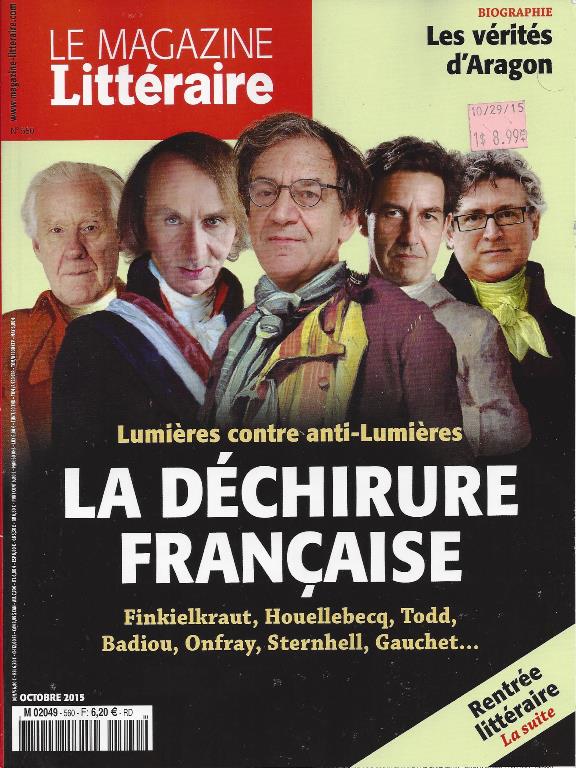
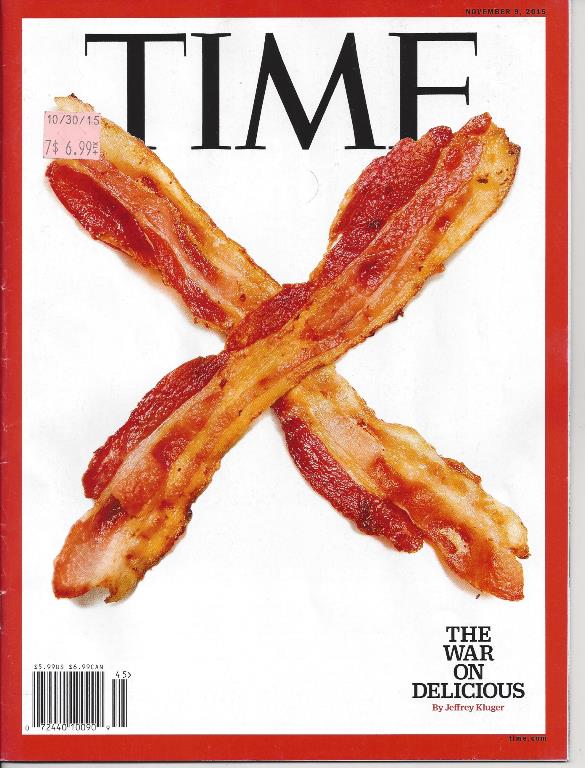
Ui
chao, đọc chỉ cái tít, là bèn nhớ ra liền cái cảm giác lần đầu tiên được
ăn cái món thịt hun khói, jambon parfumé, khi được bà cô, Cô Dung đem về
nuôi, cho ăn học, những ngày ở Hà Nội.
Nó ngon khủng khiếp đến nỗi Gấu quên con ốc nhồi ở ao làng Thanh Trì,
Quốc Oai Sơn Tây.
Chỉ đến khi đi làm Bưu Điện, có tí tiền còm rồi, thì con ốc nhồi mới thức giấc, phán, đi chứ.
Ghi chú trong ngày
Đọc bài viết của NL, thì GCC
lại nghĩ đến 1 trong những ẩn dụ, ở đầu cuốn dạy tiếng Anh, mà cái tít của
nó, là từ bài thơ của Frost, "Dừng ngựa bên rừng chiều tuyết phủ", trong
có câu, tôi còn những lời hứa, trước khi lăn ra ngủ, Promises To Keep.
Một trong những lời hứa phải
giữ, là 1 ẩn dụ, mà GCC tóm tắt sau đây.
Ẩn dụ này khiến GCC tự hỏi, nếu Cái Ác Bắc Kít gây họa, thì liệu, Cái
Đói Bắc Kít, thay vì Cái Đẹp của Dos, sẽ cứu chuộc… thế giới?
Có 1 anh chàng khi còn nghèo
khổ, được ăn 1 trái chuối, nhớ hoài, đến khi giầu có, tha hồ ăn chuối, thì
không làm sao thấy ngon như lần đầu.
Cái trái chuối đó, với GCC là
con ốc nhồi, vớt được ở cái ao, ở bên ngoài cổng nhà cô Hồng Con, cô con
gái địa chủ, sau này bị cả làng của GCC bỏ cho chết đói, và trong đêm, đói,
bịnh, khát nước [do sốt thương hàn], bò ra khỏi nhà,
tới ao, bò lết xuống, chết ngay ở bờ ao.
GGC nhớ hoài, con ốc nhồi nằm
dưới 1 đám bèo. Gấu gạt đám bèo, con ốc lộ ra, chưa kịp lặn, là thằng cu
Gấu hớt liền. Bèn nổi lửa ngay bên bờ ao, chơi liền.
Sau này, vào Nam, Gấu quá mê
món bún ốc, nhất là của cái bà có cái sạp ở Passage Eden, 1 phần là vậy.
Cũng là cái trái chuối trong ẩn dụ kể trên. Và từ đó, là vấn nạn, cái
đói BK cứu chuộc thế giới.
Còn 1 quán bún ốc, ở trong 1 cái hẻm, kế bên rạp chiếu bóng ngay đường
Lê Lợi, quán Ba Ba Bủng, hình như vậy, cũng ngon, nhưng không bằng.
SAIGON 1967 - Đường Thủ Khoa Huân
Bên trái hình có quán bún chả và bún riêu của bà Ba Bủng rất nổi tiếng
thời xưa của giới Bắc Kỳ 54 ngày xưa trước 1975...!!!
manhhai
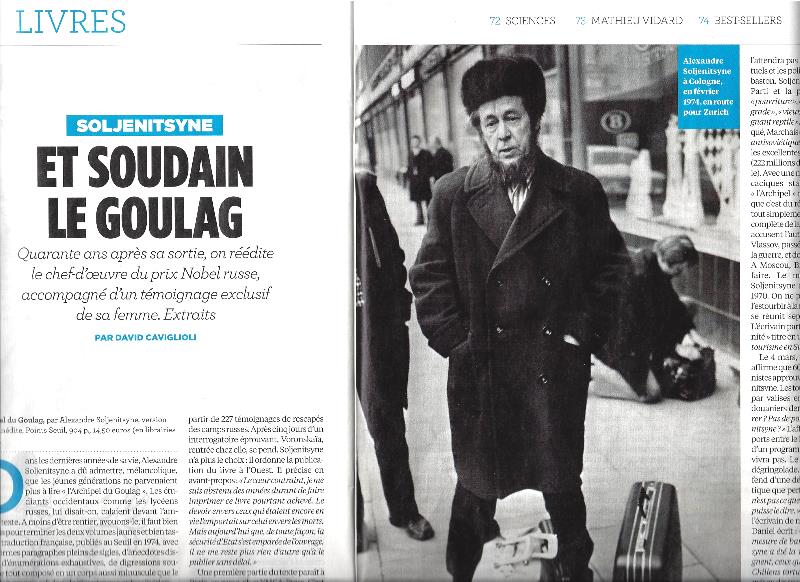
Có lẽ chưa có 1 nhà văn nào bảnh như Solz, ấy là nói về niềm
tin: Ngay từ khi bị tống ra khỏi đất nước, là đã yên chí, ta sẽ trở về,
và khi đó, chế độ Xô Viết đã sụp đổ.
Ông phán điều này, trên đài truyền hình Pháp, trong 1 chương trình
văn học do Bernard Pivot phụ trách, thời gian 1975, khi cuộc chiến Mít đi
vào khúc chót. Ông phán, Miền Bắc sẽ làm thịt Miền Nam, và đây là 1 cuộc
chiến tranh chấp quyền lợi giữa các đế quốc.
Octavio Paz sửa sai, nói, đây là cuộc chiến giải phóng của 1 cựu thuộc
địa.
Bây giờ, điều Solz phán, đã được chứng nghiệm.
Tẩy vẫn khoe, CS Mít, gốc Tẩy..
Đúng, cho tới khi HCM thoát được sự canh chừng của Cớm Tẩy, qua Moscow,
và để không bị Xì trừ khử, như 1 tên thuộc đám cựu trào, nhận làm cớm
CS quốc tế, hoạt động tại TQ.
Lần Gấu về lại Đất Bắc, coi gia phả dòng họ Nguyễn, ông chú ông bác
nào cũng khoe, tô đậm, những dòng, đã từng được du học ở TQ, là Gấu biết,
chết rồi.
Và, bất thình lình, bắt được anh Tẫu, ở trong phòng ngủ nhà
Bắc Kít của mình!
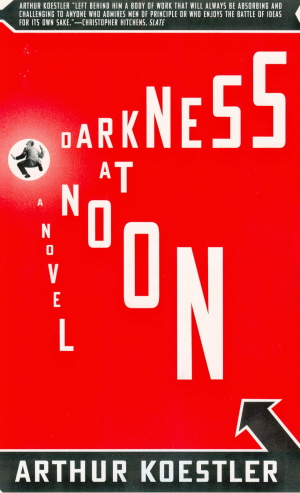
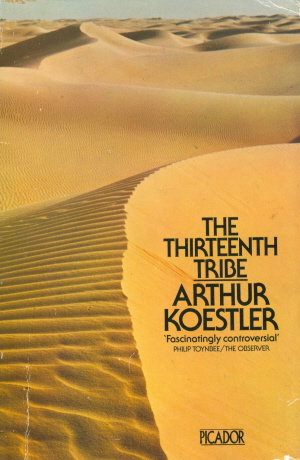
(1) Mới dinh cuốn Bóng Đêm từ một tiệm sách cũ về, cùng
với cuốn Bộ lạc thứ 13:
The Thirteenth Tribe, written near the end of his life, attempted to
prove that Ashkenazi Jews - the main body of European Jewry - were not
ethnic Jews at all but the descendants of the Khazars, Turkic nomads from
Asia who had converted to Judaism
in the eighth century. To the dismay of most Jews, the book was a huge
success and is still quoted with delight by Israel's
hostile neighbors.
Neal Ascherson: Raging towards Utopia
Gấu đọc lại
Đêm giữa Ngọ, để kiểm tra trí nhớ, và để sống lại những ngày mới vô Sài
Gòn.
Quả có mấy
xen, thí dụ, Ông số 2 đang đêm bị hai chú công an đến tóm, và ông ra lệnh
cho chú công an trẻ măng, cách mạng 30 Tháng Tư, lấy cho tao cái áo đại
quân thay vì đứng xớ rớ mân mê khẩu súng! Có cái xen ông số 2 dí mẩu thuốc
đỏ hỏn vô lòng bàn tay, và tưởng tượng ra cái cảnh mình đang được đám đệ
tử tra tấn. Có câu chuyện thê lương về anh chàng ‘Rip của Koestler’ [Giá mà
Bác Hồ hồi đó, khi ở Paris,
đọc được, thì chắc là hết dám sáng tác Giấc Ngủ 10 năm, có khi còn từ
bỏ Đảng cũng nên!]
Thà chơi bửn mà thắng, còn hơn chơi đẹp mà thua!
Trong lúc rảnh rỗi, tôi viết một cuốn
tiểu thuyết Tới và Đi, Arrival and Departure, và một số tiểu luận,
sau được đưa vô The Yogi and the Commissar [Du Già và Chính Uỷ]
Tới và Đi là tập thứ ba, trong một bộ ba tập,
trilogy, trong đó, đề tài trung tâm của nó là cuộc xung đột giữa đạo đức
và thiết thực [expediency: miễn sao có lợi, thủ đoạn, động cơ cá nhân –
khi nào, hoặc tới mức độ nào, thì một cứu cánh phong nhã [vẫn còn có thể]
biện minh cho một phương tiện dơ bẩn. Đúng là một đề tài Xưa như Diễm, nhưng
nó ám ảnh tôi suốt những năm là một đảng viên CS .
Tập đầu của bộ ba, là Những tên giác
đấu, The Gladiators, kể cuộc cách mạng [revolution] của những nô
lệ La mã, 73-71 BC, cầm đầu bởi Spartacus, xém một tí là thành công, và cái
lý do chính của sự thất bại, là, Spartacus đã thiếu quyết định [lack of determination]
– ông từ chối áp dụng luật quay đầu, trở ngược, “law of detours”; luật này
đòi hỏi, trên con đường đi tới Không Tưởng, người lãnh đạo phải “không thương
hại nhân danh thương hại”, ‘pitiless for the sake of pity’. Nôm na là, ông
từ chối xử tử những kẻ ly khai và những tên gây rối, không áp dụng luật
khủng bố - và, do từ chối áp dụng luật này khiến cho cuộc cách mạng thất
bại.
Trong Bóng
đêm giữa ban ngày, tay cựu truởng lão VC Liên Xô Rubashov đi ngược
lại, nghĩa là, ông theo đúng luật trở ngược đến tận cùng cay đắng - chỉ
để khám phá ra rằng ‘lô gíc không thôi, là một cái la bàn không hoàn hảo,
nó sẽ đưa con người vào một chuyến đi đầy dông bão, cuối cùng bến tới biến
mất trong đám sương mù.’
Hai cuốn, cuốn nọ bổ túc cho cuốn kia, và cả hai đều tận cùng bằng
tuyệt lộ.
Tribute to Koestler
In the next
TLS
Jeremy Treglown:
Whoever reads Arthur Koestler now?
Ai còn đọc K. bây giờ?
Có tớ, đây!
Bây giờ gần như mọi người đều quên ông [Koestler], nhưng đã có thời,
tất cả những sinh viên với tí mầm bất bình thế giới, họ đọc ông. Những sinh
viên, đám cháu chít của họ, hay đám trí thức “của” ngày mai, họ chẳng hề
nghe nói đến ông. Một số nhà phê bình nghĩ, sự lãng quên này thì là do những
cái nhảm nhí trong cuộc đời riêng tư của ông, hầu hết được hé lộ sau khi
ông mất: hiếp bà này, trấn bà kia, và nhất là, cái tội ép bà vợ trẻ sau cùng
cùng đi với ông trong chuyến tầu suốt. Lời giải thích sau đây thoả đáng hơn:
thời gian thay đổi. Nội dung trọn một khối của tất cả những gì mà Koestler
sống, sống sót, chiến đấu, rao giảng, lên lớp… - thời những độc tài toàn
trị, những vận động, huy động, chuyển vận… mang tính thiên niên kỷ, những
cuộc chiến toàn thể - đã biến mất. Và biến mất cùng với nó (cũng còn một tí
xíu chưa chịu biến mất), là những chọn lựa đạo đức cổ điển choàng lên lương
tâm, ý thức, [và trên vai ta đôi vầng nhật nguyệt] của hàng bao nhiêu con
người, đàn ông đàn bà của thế kỷ 20: Liệu có nên hy sinh ngày hôm nay để
có một ngày mai ca hát? Thà trốn lính chứ đừng nhẩy toán? Liệu có nên khứng
chịu con quỉ 1 sừng để tránh con quỉ 2 sừng, 10 sừng, liệu có nên đổ xuống
sợi xiềng thực dân cũ, thực dân mới máu của 3 triệu dân Mít [đứng vùng lên
gông xích ta đập tan] để có được một cái nhà nhà Mít to đẹp hơn, đàng hoàng
hơn?
Cái sự vô cảm mà tên già NN chửi đám trẻ ở trong nước, và Thầy Kuốc
ở hải ngoại, chính là vì họ không chịu chết nữa, cho những kẻ suốt đời
sống bằng máu của kẻ khác.
Bao nhiêu thế hệ Bắc Kít đã chết vì giấc mơ thống nhất?
Không đơn giản đâu.
Tên Bắc Kít LDD, suốt 1 đời chửi Mỹ Ngụy, có dịp, là bèn chuồn qua
Mẽo, làm bồi Mẽo, vậy mà có dịp là chọc quê lũ Ngụy.
Chưa hết, hắn cũng bày đặt chửi trong nước, vô cảm, trước hiện tượng
thái tử, công chúa Đỏ.
Cái tít cuốn của VTH, đúng là chôm từ
Koestler. Đâu có dễ mà kiếm ra 1 cái tít hoành tráng như thế. Cái tít Vòng
Tròn Ma Thuật, đúng là cái tít đầu tiên, bằng tiếng Đức, sau được dịch qua
tiếng Anh là Vòng tròn ma quỉ, vicious. Trong 1 bài viết trên talawas, dịch
giả tiếng Việt của nó cho biết, tính dùng cái tít Bóng Đêm Giữa Ban Ngày,
nhưng “của” VTH mất rồi!
Một tên chôm chĩa cuối cùng biến thành sở hữu chủ!
Mới xẩy ra vụ, tác giả giải Man Booker Á Châu, bị tố đạo văn.
Thoạt đầu bà chối, nhưng sau nhận.
Tờ Người Kinh Tế, biết vụ này, vẫn khen tới chỉ tác phẩm của bà.
(1)
Mít, 1 ông nhà văn, người tù vì lương tâm, như VHT, liệu
có tí can đảm, nhận, tớ có chôm cái tít của Koestler?
Cái vụ đạo thơ đang ì xèo, theo Gấu không liên quan tới đạo, mà
là ganh ăn.
PXN cũng đã từng bị talawas đánh, vì ganh ăn, đến nỗi sinh mệnh
chính trị - nồi cơm - có nguy cơ bị bể, Sến mới tha. PHT bổng lộc nhiều
quá, như PXN, chúng ghét, xúm lại đập.
Đạo gì đâu. Hai bài thơ, khác hẳn nhau. Một tên lưu vong, mù tịt
tiếng mũi lõ, không làm sao hội nhập xứ người, nhớ quê hương, khi tôi chết
nhớ quăng cái xác của tôi xuống biển, cho sóng đưa về xứ Mít, thì cũng giống
như PD năn nỉ, cho tớ về, không lẽ tớ chết, chôn ở Bắc Cực ư? Tên nào thì
cũng có bẩn ý cả. Cả hai đều về cả.
*
Người dịch cho rằng sẽ rất
hợp lý nếu chuyển ngữ tên tác phẩm này thành Đêm giữa ban ngày nếu như
trước đó chưa có một tác phẩm đã rất nổi tiếng cùng tên của nhà văn Vũ Thư
Hiên.
PMN
Đấy là ông viết. Còn trong bụng, ông nghĩ: Tay
mũi lõ này ăn cắp cái tít của "bạn ta", là VTH!
Xin trao thi sĩ vòng hoa tặng
Auden, nhà thơ người Anh, khi được hỏi,
hãy chọn bông hoa đẹp nhất trong vòng hoa tặng, ông cho biết, bông hoa đó
đã tới với ông một cách thật là khác thường. Bạn của ông, Dorothy Day, bị
bắt giam vì tham gia biểu tình. Ở trong tù, mỗi tuần, chỉ một lần vào thứ
bẩy, là nữ tù nhân được phép lũ lượt xếp hàng đi tắm. Và một lần, trong đám
họ, một tiếng thơ cất lên, thơ của ông, bằng một giọng dõng dạc như một
tuyên ngôn:
"Hàng trăm người sống không cần tình yêu,
Nhưng chẳng có kẻ nào sống mà không cần nước"
Khi nghe kể lại, ông hiểu rằng, đã không vô ích, khi làm thơ.
Chúng ta đã thắng trước cuộc đời.
Cũng trong cuộc phỏng vấn,
khi được hỏi, ông làm thơ cho ai, Auden trả lời: nếu có người hỏi tôi như
vậy, tôi sẽ hỏi lại, "Bạn có đọc thơ tôi?" Nếu nói có, tôi sẽ hỏi tiếp,
"Bạn thích thơ tôi không?" Nếu nói không, tôi sẽ trả lời, "Thơ của tôi không
dành cho bạn."
Tôi tản mạn về một nhà thơ nước ngoài như trên, là
để nói ra điều này: thế hệ nhà thơ nào cũng muốn chứng tỏ một điều: chúng
tôi không vô ích, khi làm thơ. Nếu mỗi thế hệ là một quốc gia non trẻ ,
và, nếu thế hệ đàn anh của chúng tôi tượng trưng cho nước Việt non trẻ
- vừa mới giành được độc lập - là bước ngay vào cuộc chiến, và, họ đã chứng
tỏ được điều trên: đã không vô ích khi làm thơ; và đã thắng trước cuộc đời,
cho nên đây là một thách đố đối với những nhà thơ trẻ như chúng tôi: đừng
làm cho thơ trở thành vô ích. Và nếu thơ của lớp đàn anh chúng
tôi đã làm xong phần đóng góp cho sự nghiệp chung của dân tộc, thơ của thế
hệ trẻ chúng tôi có lẽ sẽ làm nốt phần còn lại: thơ sẽ nói lên nghệ thuật
của sự tưởng niệm, và mỗi bài thơ, được viết đúng lúc như thế đó, sẽ trở
thành một khúc kinh cầu. Đó là tham vọng của thơ trẻ.
Note: Bài viết này, có phần đóng
góp của Gấu.
Nhớ, gửi cho PTH, VB, anh mail, reply, phần đầu OK.
Phần sau, dởm.
Gấu Cái lắc đầu, anh PTH giỏi thật!
Lướt net, thấy PHT lại dính thêm
1 đòn nữa.
Theo Gấu, vẫn không phải đạo.
Với vụ Du Tử Cà, có thể dùng 1 hình ảnh, đốt ngọn nến hai đầu, để
diễn tả cùng 1 hình ảnh, của kẻ ở bên ngoài, và kẻ ở bên trong, cùng hãy
ném thây tôi xuống biển.
Vụ mới này, Mai Thảo gọi là thơ đồng phục, nghĩa là dở như nhau, ai
đạo của ai thì cũng thế.
Có thể, chính vì thế mà PHT mới nói, bài thơ của tôi in sau, bài của
bạn in trước, [chúng giống nhau vì cùng tệ như nhau].
Thứ thơ tản mạn bên ly cà phê, ngồi bên ly cà phê nhớ người yêu &
bạn quí… quá cả đồng phục mà đúng là 1 trận Đại Hồng Thuỷ của 1 cõi thơ
Mít, từ trong nước tới hải ngoại.
Borges có câu, thơ là để trao cho
thi sĩ.
Câu thơ sau đây, của PHT, không ai đạo được, đúng thứ thơ để trao cho
thi sĩ:
buồn tập tễnh
về ăn giỗ mình
Tuy nhiên, thứ thơ mà mỗi bài thơ
là 1 tưởng niệm, PHT không làm được.
Chắc là do bổng lộc nhiều quá.
Và, nếu như thế, thì
đây đúng là lúc, để, thay vì Huyền Thư, thì là Phần Thư?
"Về ăn giỗ mình", là... lúc này?
Sẹo Độc Lập vs Điêu Tàn ư đâu chỉ có
Điêu Tàn?
Tôi chỉ ngạc nhiên về sự phi logic mà ít người nhận ra "làm
thế nào để chị Thường Đoan đạo thơ của Phan Huyền Thư khi mà chính chủ
nhân của nó giấu kỹ thơ trong hộc bàn của mình, chả ai biết cả từ năm 1996?
Hay chị Thường Đoan có chìa khóa buồng nhà Thư? Hay một nhà thơ ở VN có
thể đặt Hợp Lưu và Tạp chí Thơ dài hạn nên đọc được bài thơ trên đó, trong
khi chính tác giả cũng không biết hai tạp chí trên có đăng hay không"? Thư
thật thiếu dũng cảm nhận lỗi! Minh Quang Hà
Tho Nguyen Van@Thai
Lê Thị Thái Hoà
Đấng này, bạn thân của PHT, vậy mà cũng
đánh hôi!
Xin đừng làm chữ của tôi đau
Nguyễn Huy Thiệp
viết về PHT
Cái giờ nghiêm trọng của đời mày đang điểm. Bây giờ hoặc là
không có bao giờ nữa. Mày phải cương quyết. Không có thứ nhân đạo nào cấm
mày không được tàn nhẫn ngay với mày. Mày hãy diệt hết những con người cũ
ở trong mày đi – những con người mà mày mệnh danh là cố nhân, theo một cái
cố tật ưa du dương với kỷ niệm. Đào thải, chưa đủ. Phải tàn sát. Giết, giết
hết. Thò đứa nào ở dĩ vãng hiện về đòi hỏi bất cứ một tí gì của mày bây giờ,
là mày phải giết ngay. Mày phải tự hoại nội tâm của mày đi đã. Mà hãy lấy
mày ra làm lửa mà đốt cháy hết những phong cảnh cũ của tâm tưởng mày”… Chàng
chạy ra đường. Ngoài đường, cuộc Cách Mệnh đang bước dài trên khắp ngả phố.
Trên các cửa sổ mở, gió đời lùa cờ máu bay theo một chiều… Nguyễn thấy mệt
mỏi trong lòng và trên thân chàng thì xót nhức vô cùng. Thì ra, lúc ở nhà
ra đi, chàng vừa chịu xong một cái nhục hình. Lý trí đã lột hết lượt da trên
mình Nguyễn… Cái luồng gió ban nãy thổi cờ máu, thổi mãi vào thịt non Nguyễn
đang se dần lại. Nguyễn thèm đến một con rắn mỗi năm thoát xác một lần…
Trích “Lột Xác”, của Nguyễn Tuân, in trong tuyển tập Nguyễn Tuân,
tập I, nhà xuất bản Văn Học, Hà Nội, ấn bản năm 2000.
Từ "cờ máu", là của Nguyễn Tuân, không phải của lũ Ngụy.
Tiếng chim khua vỡ buổi sáng lạnh
http://giaitri.vnexpress.net/tin-tuc/sach/lang-van/phan-huyen-thu-khang-dinh-viet-bai-tho-gay-tranh-cai-19-nam-truoc-3298707-p3.html
Những ai buộc tội PHT đạo thơ, trong hai trường hợp đang được nhắc
tới, theo Gấu, đều chưa từng làm thơ, hoặc chỉ làm thứ thơ nhì nhằng, bởi
là vì 1 người mà làm nổi 1 câu thơ “được trao cho thi sĩ”, theo ý của Borges,
không thèm đạo thơ của bất cứ ai, vì, làm sao hay hơn, của chính ta đây?
Rõ như ban ngày.
Cả bai bài thơ, từ chìa khoá của chúng, là khua, khuấy, blues, buổi
sáng, đều từ… thơ TTT, nhớ 1 câu, sáng mai “khua” thức nhiều nhớ thương,
bị lầm thành “khuya” thức.
Từ trái, các ca sĩ Quỳnh Giao,
Mai Hương, Thái Thanh.
WESTMINSTER
(VB) -- Hơn 120 người đã dự buổi Tưởng Niệm Thanh Tâm Tuyền đêm Thứ Năm
30-3-2006 tại Phòng Sinh Hoạt Nhật Báo Việt Báo.
Ca sĩ Lệ Thu được mời hát bài Dạ Tâm Khúc, một bản nhạc được Phạm
Đình Chương phổ từ thơ Thanh Tâm Tuyền.
Chị kể thời còn ở Sài Gòn, cứ hát nhầm, “đưa em vào quán rượu” thành
“đưa em vào quán trọ” và một lần được nhà thơ ghé tai vừa chỉnh vừa đùa...
Thanh Tâm Tuyền cũng đã từng kể, về một câu thơ của ông "sáng mai khua thức nhiều nhớ thương", bị ông thợ
nhà in sửa thành "sáng mai khuya
thức..."
Gấu nhắc tới “ông anh của mình”, ở đây, là để cho thấy, có khi, bạn
“ảnh hưởng” [đạo] mà không biết mình, đạo.
Trên TV có kể về giai thoại thú vị liên quan tới nhà thơ Beckett.
Nhưng tuyệt nhất, là bài viết của Borges, về những vị thầy [tiền thân,
người đi trước], precursors, của Kafka.
Bản thân Gấu, thuổng Borges, khi viết về cuốn Bếp Lửa của TTT, vào
năm 1972, chỉ đến khi ra hải ngoại, thì mới biết, của ông.
Hay là bài viết về “ảnh hưởng” của Rushdie, cũng đã đăng trên Tin
Văn.
Trường hợp Sến, trên talawas, ra lệnh cho 1 tên Cớm văn học đánh PHT,
khi bà này làm cái poster TTT, trong ngày hội thơ ở Văn Miếu, ngay khi
đó, Gấu đã chỉ ra, những gì PHT đạo, chỉ là những information, tài liệu,
có sẵn trên báo chí. Ăn cắp cái gì, khi chúng sờ sờ ra đấy. Một khi xb thành
sách, thí dụ, nếu cần, thì để vô phần tiểu chú.
Một việc làm ý nghĩa như thế, mà cũng bị 1 lũ nhơ bẩn xúm vào đánh.
Chuyện đang xẩy ra bây giờ thì cũng vậy.
Ganh ăn, ghen tài…. thế là xúm lại, đâu có khác gì mấy cái clip video
You tube, cho thấy cái sự dã man của giống Mít.
…. Giữa đông, giữa năm 1973, lạnh cứng người, cô đơn, túi thủng, tôi
đành phải làm cái trò đọc thơ, vào lúc tám giờ tối, tại Trung Tâm Văn Hóa
Mỹ ở con phố Dragon.... với cái giá năm chục đô. Tôi có cái uống với Beckett
vào lúc bẩy giờ. Tôi đâu dám xì ra cái chuyện đọc thơ, bởi vì, tôi nghĩ
ông chẳng ưa cái chuyện đọc thơ trước công chúng, cho dù phải cạp đất, và
ông gần như chẳng bao giờ làm chuyện đó.
Trong lúc cà kê, ông có vẻ đâu đâu. Dưng không, ông nói: "Bạn đọc
thơ, phải không?" Tôi chới với, làm sao ông biết? Rồi ông thêm: "Chắc mong
bạn bè tới đông, hẻ?". Hiển nhiên, tôi làm ông đau, khi không mời. Vậy
là tôi đã làm ông đau, bực thiệt! Ông nói, như cho tôi đỡ đau: "Không,
cám ơn bạn, tôi không bao giờ tới với những chuyện đó".
Rồi thì ông yêu cầu tôi đọc một bài thơ, của tôi, cho ông nghe. Nhột
quá, tôi bảo ông, cái giá năm mươi đô là ổn, đối với tôi. Ông bật cười,
tuy nhiên vẫn bắt tôi đọc thơ cho bằng được. Thơ đọc thầm lén mà!
Thế là tôi ư ử, bài "Trên Đại Lộ Raspail":
How easily our only smile smiles.
We will never agree or disagree.
The pretty girl is perfected in her passing.
Our love lives within the space of a quietly closing door
Ông chăm chú nghe, mắt nhắm tít. "Được! Được!", ông nói.
"Ồ, c...! " Tôi bật lên. Ông mở choàng mắt, và tôi tự giải thích:
"Tớ ăn cắp của bạn!"
"Không, không. Tôi chưa hề nghe nó trong đời..."
"Không, không, của bạn! Bài 'Dieppe'..., bạn chấm dứt với 'the space
of a door that opens and shuts'
"Ô! Đúng thế thực." Nhưng rồi, bỗng nhiên, ông thêm vô: "Ô, c...!"
"Chuyện gì nữa, hả?", tôi hỏi.
"Tôi chôm của Dante, chính tôi!
Tiền Thân Kafka
Trầm
luân vì niềm tin
Note: Cuốn Đêm Giữa Ban Ngày của Koestler đúng
là 1 thứ vắc xin đối với Gấu, những ngày mới lớn, và không chỉ Gấu, mà cả
Âu Châu. Không có nó, và “1984” của Orwell, là Xì nhuộm đỏ cả thế giới rồi!
Koestler
Raging towards Utopia
Điểm Sách
London đọc tiểu sử Koestler của
Scammell
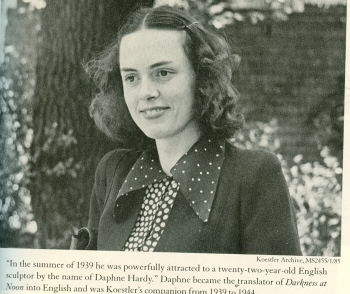
Em này là
tác giả cái tít cuốn sách của VTH: Đêm giữa ban ngày!
Cái tít Đêm giữa Ngọ, như trong cuốn tiểu sử K của Scammell cho biết,
K. nghĩ rằng, được trích dẫn từ Samson Agonistes của Milton: “Oh dark, dark,
dark, amid the blaze of noon”. Thực sự, Daphne được gợi hứng từ Sách của [Book of] Job: “They meet with darkness in the daytime,
and grope in the noonday as in the night” [Job 5:14]
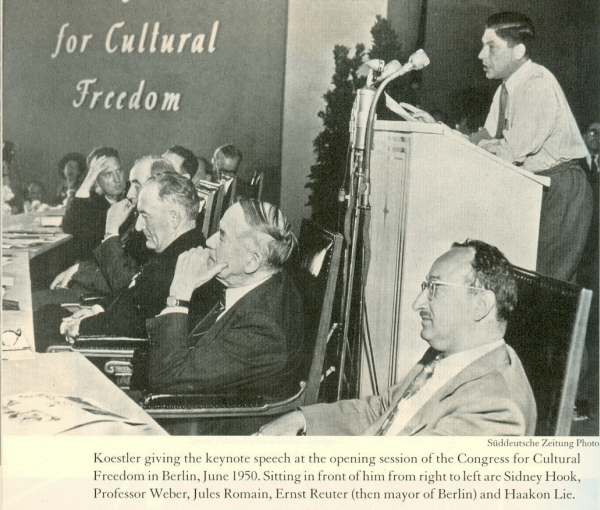
K. mở ra ‘cái gọi là’ Mặt
trận bảo vệ văn hóa tự do, với anh Hai chi địa, là Xịa. ST có là nhờ nó.
Chương trình WJC chắc cũng từ đó.
[Từ đó trong tôi bừng nắng hạ!] Bộ sách vĩ đại Văn Học Miền Nam của
VP chắc cũng là từ đó! Lẽ dĩ nhiên, dưới những cái tên chi địa khác! Rockefeller
Foundation, thí dụ. Nhưng đều là đô la Mẽo cả!
*
“My analysis of Koestler is: one third genius, one third blackguard,
and one third lunatic”, [Tôi nhận xét K. 1/3 thiên tài, 1/3 đê tiện, và
1/3 khủng, mát] tay cảnh sát chìm giả làm tù nhân bị nhốt cùng phòng với
K, tại nhà tù Pentonville, báo cáo với sếp.


(1) Mới dinh cuốn Bóng Đêm từ một tiệm sách cũ về, cùng
với cuốn Bộ lạc thứ 13:
The Thirteenth Tribe, written near the end of his life, attempted to
prove that Ashkenazi Jews - the main body of European Jewry - were not
ethnic Jews at all but the descendants of the Khazars, Turkic nomads from
Asia who had converted to Judaism
in the eighth century. To the dismay of most Jews, the book was a huge
success and is still quoted with delight by Israel's
hostile neighbors.
Neal Ascherson: Raging towards Utopia
Gấu đọc lại
Đêm giữa Ngọ, để kiểm tra trí nhớ, và để sống lại những ngày mới vô Sài
Gòn.
Quả có mấy
xen, thí dụ, Ông số 2 đang đêm bị hai chú công an đến tóm, và ông ra lệnh
cho chú công an trẻ măng, cách mạng 30 Tháng Tư, lấy cho tao cái áo đại
quân thay vì đứng xớ rớ mân mê khẩu súng! Có cái xen ông số 2 dí mẩu thuốc
đỏ hỏn vô lòng bàn tay, và tưởng tượng ra cái cảnh mình đang được đám đệ
tử tra tấn. Có câu chuyện thê lương về anh chàng ‘Rip của Koestler’ [Giá mà
Bác Hồ hồi đó, khi ở Paris,
đọc được, thì chắc là hết dám sáng tác Giấc Ngủ 10 năm, có khi còn từ
bỏ Đảng cũng nên!]
Thà chơi bửn mà thắng, còn hơn chơi đẹp mà thua!
Trong lúc rảnh rỗi, tôi viết một cuốn
tiểu thuyết Tới và Đi, Arrival and Departure, và một số tiểu luận,
sau được đưa vô The Yogi and the Commissar [Du Già và Chính Uỷ]
Tới và Đi là tập thứ ba, trong một bộ ba tập,
trilogy, trong đó, đề tài trung tâm của nó là cuộc xung đột giữa đạo đức
và thiết thực [expediency: miễn sao có lợi, thủ đoạn, động cơ cá nhân –
khi nào, hoặc tới mức độ nào, thì một cứu cánh phong nhã [vẫn còn có thể]
biện minh cho một phương tiện dơ bẩn. Đúng là một đề tài Xưa như Diễm, nhưng
nó ám ảnh tôi suốt những năm là một đảng viên CS .
Tập đầu của bộ ba, là Những tên giác
đấu, The Gladiators, kể cuộc cách mạng [revolution] của những nô
lệ La mã, 73-71 BC, cầm đầu bởi Spartacus, xém một tí là thành công, và cái
lý do chính của sự thất bại, là, Spartacus đã thiếu quyết định [lack of determination]
– ông từ chối áp dụng luật quay đầu, trở ngược, “law of detours”; luật này
đòi hỏi, trên con đường đi tới Không Tưởng, người lãnh đạo phải “không thương
hại nhân danh thương hại”, ‘pitiless for the sake of pity’. Nôm na là, ông
từ chối xử tử những kẻ ly khai và những tên gây rối, không áp dụng luật
khủng bố - và, do từ chối áp dụng luật này khiến cho cuộc cách mạng thất
bại.
Trong Bóng
đêm giữa ban ngày, tay cựu truởng lão VC Liên Xô Rubashov đi ngược
lại, nghĩa là, ông theo đúng luật trở ngược đến tận cùng cay đắng - chỉ
để khám phá ra rằng ‘lô gíc không thôi, là một cái la bàn không hoàn hảo,
nó sẽ đưa con người vào một chuyến đi đầy dông bão, cuối cùng bến tới biến
mất trong đám sương mù.’
Hai cuốn, cuốn nọ bổ túc cho cuốn kia, và cả hai đều tận cùng bằng
tuyệt lộ.
Tribute to Koestler
In the next
TLS
Jeremy Treglown:
Whoever reads Arthur Koestler now?
Ai còn đọc K. bây giờ?
Có tớ, đây!
Bây giờ gần như mọi người đều quên ông [Koestler], nhưng đã có thời,
tất cả những sinh viên với tí mầm bất bình thế giới, họ đọc ông. Những
sinh viên, đám cháu chít của họ, hay đám trí thức “của” ngày mai, họ chẳng
hề nghe nói đến ông. Một số nhà phê bình nghĩ, sự lãng quên này thì là
do những cái nhảm nhí trong cuộc đời riêng tư của ông, hầu hết được hé
lộ sau khi ông mất: hiếp bà này, trấn bà kia, và nhất là, cái tội ép bà
vợ trẻ sau cùng cùng đi với ông trong chuyến tầu suốt. Lời giải thích sau
đây thoả đáng hơn: thời gian thay đổi. Nội dung trọn một khối của tất cả
những gì mà Koestler sống, sống sót, chiến đấu, rao giảng, lên lớp… - thời
những độc tài toàn trị, những vận động, huy động, chuyển vận… mang tính
thiên niên kỷ, những cuộc chiến toàn thể - đã biến mất. Và biến mất cùng
với nó (cũng còn một tí xíu chưa chịu biến mất), là những chọn lựa đạo đức
cổ điển choàng lên lương tâm, ý thức, [và trên vai ta đôi vầng nhật nguyệt]
của hàng bao nhiêu con người, đàn ông đàn bà của thế kỷ 20: Liệu có nên
hy sinh ngày hôm nay để có một ngày mai ca hát? Thà trốn lính chứ đừng nhẩy
toán? Liệu có nên khứng chịu con quỉ 1 sừng để tránh con quỉ 2 sừng, 10 sừng,
liệu có nên đổ xuống sợi xiềng thực dân cũ, thực dân mới máu của 3 triệu
dân Mít [đứng vùng lên gông xích ta đập tan] để có được một cái nhà nhà Mít
to đẹp hơn, đàng hoàng hơn?
Cái sự vô cảm mà tên già NN chửi đám trẻ ở trong nước, và Thầy Kuốc
ở hải ngoại, chính là vì họ không chịu chết nữa, cho những kẻ suốt đời sống
bằng máu của kẻ khác.
Bao nhiêu thế hệ Bắc Kít đã chết vì giấc mơ thống nhất?
Không đơn giản đâu.
Tên Bắc Kít LDD, suốt 1 đời chửi Mỹ Ngụy, có dịp, là bèn chuồn qua
Mẽo, làm bồi Mẽo, vậy mà có dịp là chọc quê lũ Ngụy.
Chưa hết, hắn cũng bày đặt chửi trong nước, vô cảm, trước hiện tượng
thái tử, công chúa Đỏ.
Cái tít cuốn của VTH, đúng là chôm từ
Koestler. Đâu có dễ mà kiếm ra 1 cái tít hoành tráng như thế. Cái tít Vòng
Tròn Ma Thuật, đúng là cái tít đầu tiên, bằng tiếng Đức, sau được dịch qua
tiếng Anh là Vòng tròn ma quỉ, vicious. Trong 1 bài viết trên talawas, dịch
giả tiếng Việt của nó cho biết, tính dùng cái tít Bóng Đêm Giữa Ban Ngày,
nhưng “của” VTH mất rồi!
Một tên chôm chĩa cuối cùng biến thành sở hữu chủ!
Mới xẩy ra vụ, tác giả giải Man Booker Á Châu, bị tố đạo văn.
Thoạt đầu bà chối, nhưng sau nhận.
Tờ Người Kinh Tế, biết vụ này, vẫn khen tới chỉ tác phẩm của bà. (1)
Mít, 1 ông nhà văn, người tù vì lương tâm, như VHT, liệu
có tí can đảm, nhận, tớ có chôm cái tít của Koestler?
Cái vụ đạo thơ đang ì xèo, theo Gấu không liên quan tới đạo, mà là
ganh ăn.
PXN cũng đã từng bị talawas đánh, vì ganh ăn, đến nỗi sinh mệnh chính
trị - nồi cơm - có nguy cơ bị bể, Sến mới tha. PHT bổng lộc nhiều quá, như
PXN, chúng ghét, xúm lại đập.
Đạo gì đâu. Hai bài thơ, khác hẳn nhau. Một tên lưu vong, mù tịt tiếng
mũi lõ, không làm sao hội nhập xứ người, nhớ quê hương, khi tôi chết nhớ
quăng cái xác của tôi xuống biển, cho sóng đưa về xứ Mít, thì cũng giống
như PD năn nỉ, cho tớ về, không lẽ tớ chết, chôn ở Bắc Cực ư? Tên nào thì
cũng có bẩn ý cả. Cả hai đều về cả.
*
Người dịch cho rằng sẽ rất hợp
lý nếu chuyển ngữ tên tác phẩm này thành Đêm giữa ban ngày nếu như trước
đó chưa có một tác phẩm đã rất nổi tiếng cùng tên của nhà văn Vũ Thư Hiên.
PMN
Đấy là ông viết. Còn trong bụng, ông nghĩ: Tay
mũi lõ này ăn cắp cái tít của "bạn ta", là VTH!
Xin trao thi sĩ vòng hoa tặng
Auden, nhà thơ người Anh, khi được hỏi,
hãy chọn bông hoa đẹp nhất trong vòng hoa tặng, ông cho biết, bông hoa đó
đã tới với ông một cách thật là khác thường. Bạn của ông, Dorothy Day, bị
bắt giam vì tham gia biểu tình. Ở trong tù, mỗi tuần, chỉ một lần vào thứ
bẩy, là nữ tù nhân được phép lũ lượt xếp hàng đi tắm. Và một lần, trong đám
họ, một tiếng thơ cất lên, thơ của ông, bằng một giọng dõng dạc như một
tuyên ngôn:
"Hàng trăm người sống không cần tình yêu,
Nhưng chẳng có kẻ nào sống mà không cần nước"
Khi nghe kể lại, ông hiểu rằng, đã không vô ích, khi làm thơ.
Chúng ta đã thắng trước cuộc đời.
Cũng trong cuộc phỏng vấn,
khi được hỏi, ông làm thơ cho ai, Auden trả lời: nếu có người hỏi tôi như
vậy, tôi sẽ hỏi lại, "Bạn có đọc thơ tôi?" Nếu nói có, tôi sẽ hỏi tiếp,
"Bạn thích thơ tôi không?" Nếu nói không, tôi sẽ trả lời, "Thơ của tôi không
dành cho bạn."
Tôi tản mạn về một nhà thơ nước ngoài như trên, là
để nói ra điều này: thế hệ nhà thơ nào cũng muốn chứng tỏ một điều: chúng
tôi không vô ích, khi làm thơ. Nếu mỗi thế hệ là một quốc gia non trẻ ,
và, nếu thế hệ đàn anh của chúng tôi tượng trưng cho nước Việt non trẻ
- vừa mới giành được độc lập - là bước ngay vào cuộc chiến, và, họ đã chứng
tỏ được điều trên: đã không vô ích khi làm thơ; và đã thắng trước cuộc đời,
cho nên đây là một thách đố đối với những nhà thơ trẻ như chúng tôi: đừng
làm cho thơ trở thành vô ích. Và nếu thơ của lớp đàn anh chúng
tôi đã làm xong phần đóng góp cho sự nghiệp chung của dân tộc, thơ của thế
hệ trẻ chúng tôi có lẽ sẽ làm nốt phần còn lại: thơ sẽ nói lên nghệ thuật
của sự tưởng niệm, và mỗi bài thơ, được viết đúng lúc như thế đó, sẽ trở
thành một khúc kinh cầu. Đó là tham vọng của thơ trẻ.
Note: Bài viết này, có phần đóng
góp của Gấu.
Nhớ, gửi cho PTH, VB, anh mail, reply, phần đầu OK.
Phần sau, dởm.
Gấu Cái lắc đầu, anh PTH giỏi thật!
Lướt net, thấy PHT lại dính thêm 1 đòn
nữa.
Theo Gấu, vẫn không phải đạo.
Với vụ Du Tử Cà, có thể dùng 1 hình ảnh, đốt ngọn nến hai đầu, để
diễn tả cùng 1 hình ảnh, của kẻ ở bên ngoài, và kẻ ở bên trong, cùng hãy
ném thây tôi xuống
biển.
Vụ mới này, Mai Thảo gọi là thơ đồng
phục, nghĩa là dở như nhau, ai đạo của ai thì cũng thế.
Chính vì thế mà PHT mới nói, bài thơ của tôi in sau, bài của bạn in
trước, [chúng giống nhau vì cùng tệ như nhau].
Borges có câu, thơ là để trao cho thi
sĩ.
Câu thơ sau đây, của PHT, không ai đạo được, vì đúng thứ thơ để trao
cho thi sĩ:
buồn tập tễnh
về ăn giỗ mình
PHT
NGUYỄN HƯNG QUỐC: Trong các tác phẩm được Võ Phiến hoàn thành
tại Hoa Kỳ sau năm 1975, bộ Văn học Miền Nam là công trình dài hơi và được
ông dành cho nhiều tâm huyết nhất. Thật ra, ngay trước 1975, tại Sài Gòn,
Võ Phiến đã manh nha ý định viết về văn học Miền Nam; sau năm 1975, từ
Mỹ, nhìn thấy nền văn học ấy bị chính quyền mới ra sức huỷ diệt, chạnh
lòng, ông càng thiết tha hơn trong việc thực hiện giấc mơ ngày nào. Khoảng
năm 1983, qua sự giới thiệu của Huỳnh Sanh Thông, ôn...
See More
Note: Nhảm.
Ngay ở đầu cuốn VHTQ, VP đã phán, tớ đếch viết được phê bình, làm gì
có chuyện ở Sài Gòn, trước 1975 đã… manh nha?
Cái vụ lãnh đô la của Mẽo, viết VHTQ, VP đâu có dám nhắc tới?
Ông lấy từ 1 cơ quan có cái tên Mít đặc, vì vẫn bị ám ảnh bởi vụ Sáng
Tạo nhận tiền của Xịa.
Hồi mới ra hải ngoại, đọc VHTQ, Gấu bị lầm, cứ nghĩ có 1 cơ quan Mít
hải ngoại lo cái việc phát tiền viết về văn học miền nam trước 1975, tếu
thế, và tính viết thư xin tí tiền gửi cho lũ nhỏ còn kẹt lại.
Trong VHTQ, VP viết cực nhảm về Sáng Tạo, về Mặc Đỗ, về Nhất Hạnh,
về nhất nhiều người, chạnh lòng cái con khỉ.
Viết thì phải trung thực. Không thì đừng viết.
Cuốn VHTQ còn đó, đọc thì biết.
Trong số những người viết về VP, Gấu được coi là viết đúng nhất về
ông, ngay từ khi ông còn sống.
[Coi Blog NL, thí dụ]
Ông cũng đã từng nhắn mời Gấu tới nhà, khi biết Gấu qua Cali, khi ông
từ Los về Little Saigon, nhưng ham vui bạn bè, Gấu quên.
Lần đầu tiên 1998, qua Cali, nhân xb cuốn Lần Cuối Saigon, Nguyễn Mộng
Giác mở 1 bữa tiệc tại gia, theo kiểu ra mắt sách, cả băng VH hiện diện,
không thấy VP, Gấu hỏi, NMG nói, có mời, nhưng không tới.
THÁI TỬ ĐỎ TRÀN NGẬP ĐẤT NƯỚC - PHÚC HAY HỌA?
Khi các thái tử và công chúa, các cậu ấm cô chiêu vụt nổi
lên “chói sáng” trên chính trường Việt Nam, đâu đó có thể có người mừng
khấp khởi, nghĩ rằng các cô cậu ấy sẽ chính là “tầng lớp kỹ trị mà Việt
Nam cần”, rằng các cô cậu trẻ, giỏi, có bằng cấp Tây học và sự văn minh hấp
thụ từ Âu-Mỹ, các cô cậu sẽ giúp dân chủ hóa Việt Nam.
Và như thế phải chăng là kết quả của một chiến lược sâu xa
nào đó của Mỹ, “dùng cộng sản con diệt cộn...
See More
Salvation or Ruin?
Cứu rỗi hay Điêu tàn?
Trong một xã hội tan rã, một khi thế hệ trẻ mù lòa đi theo chân lý
muôn đời, tiến trình tự nhiên của điêu tàn, huỷ diệt, hết cắm cờ, thì
lại ngồi lên đầu nhân dân, tai ương thảm họa là điều không thể tránh khỏi,
và được báo trước. Nhưng chính cứu rỗi, chứ không phải điêu tàn, mới là
điều "tới mà chẳng ai biết trước, chẳng ai trông chờ, chẳng làm sao tiên
đoán...", bởi vì cứu rỗi, chính nó, chứ không phải điêu tàn, tuỳ thuộc vào
tự do và ý chí của con người.
[Mô phỏng Hannah Arendt, trong Franz Kafka: A Revaluation, trong Essays
in Understanding 1930-1954, nhà xb Schocken Books, New York: In
a dissolving society which blindly follows the natural course of ruin, catastrophe
can be foreseen. Only salvation not ruin, comes unexpectedly, for salvation
and not ruin depends upon the liberty and the will of men].
Lại nói về tầng lớp tinh anh trí thức tốt nghiệp nơi những trường
đại học danh tiếng.
Ngụy chẳng đã từng nưng niu lũ này, cỡ nào. Cả 1 chính sách hoãn dịch
vì lý do học vấn, du học… là để cho lũ này sống sót, hết chiến tranh lo
xây dựng lại đất nước, đúng ý Bác Hồ, nhưng kết quả ra sao, thì chúng ta
đều biết, chúng rắp tâm nằm vùng, hoặc phản chiến, hoặc bỏ chạy qua Canada,
thí dụ, đếch về, nếu bị gọi về. Không có lấy 1 mống nào ra hồn, ngay cả những
tên làm cho các tòa đại sứ Ngụy, thí dụ.
Có tên còn nhân dịp bợ luôn cái két sắt, vì, không lẽ để cho VC?
Hà hà!
Steiner quá đau đớn, vì không được chết cùng với tất cả những tên
Do Thái Âu Châu, nhờ 1 ông bố Do Thái đưa kịp gia đình, trên chuyến tàu
chót rời cựu lục địa.
Mít chưa từng có 1 tên đau nỗi đau này!
Khủng hoảng và khủng bố
https://nhacsituankhanh.wordpress.com/2015/10/12/khung-hoang-va-khung-bo/
Ở thế kỷ 21, khi một cá nhân hay một tổ chức gây sai
lầm – để giải quyết khủng hoảng – người ta thường vẽ ra những kịch bản để
cứu vớt chiếc tàu đang đắm. Có những kịch bản rất thông minh và được ngợi
ca như sách giáo khoa về ứng xử tình huống, nhưng cũng có những loại kịch
bản rẻ tiền và đáng khinh, mãi mãi là điều để đàm tiếu.
Kịch bản giải quyết khủng hoảng của công an Hà Nội để đối phó với
cái chết của em Đỗ Đăng Dư là một loại vô cùng đáng khinh như vậy. Ghê
tởm nhất là để bảo vệ cho mình, phủi bỏ trách nhiệm với công dân, toàn
thể trai tài gái sắc của công an Hà Nội đã không ngại giẫm đạp lên linh
hồn một thiếu niên đã qua đời, tự tô trát lên gương mặt mình sự vô hại như
thứ phường tuồng.
Bằng một văn bản như công báo gửi chung đến nhiều tờ báo, kẻ mớm kịch
bản cho công an Hà Nội đã chăm chút cách nhấn mạnh vào nhân thân của em
Đỗ Đăng Dư là từng trộm cắp, thành phần bất hảo… mục đích là sử dụng phép
nguỵ biện tấn công cá nhân (ad hominem) để làm mờ đi sai lầm của phía cơ
quan công an. Phương thức này rất quen gặp lâu nay, nên cũng cần tự hỏi rằng
đó có là kịch bản giáo khoa chuyên ngành?
Bất hảo thì sao? Bất hảo thì chết trong tay công an là không quan
trọng? Tháng 3, năm 1991, Rodney King bị tình nghi sử dụng và trữ ma tuý,
bị 2 xe cảnh sát rượt đuổi ở San Fernando Valley. Anh Rodney King chạy đến
110km/giờ, bất chấp lời kêu gọi dừng lại. Sau khi bắt được Rodney King,
4 viên cảnh sát đã thay nhau đánh đập người da đen này đến nứt sọ, rách
mặt và gãy răng. Một cuộc nổi dậy sau đó của cộng đồng Mỹ da đen tưởng chừng
làm nước Mỹ đi đến bờ vực nội chiến. Sau đó thì 4 viên cảnh sát bị kết án
và Rodney King được bồi thường, trở thành một hình tượng lịch sử của luật
pháp Mỹ “dù anh là ai, anh vẫn được bảo vệ bởi luật pháp”.
Đừng quên là 4 viên cảnh sát to khoẻ, đánh đập bằng tay, chân và dùi
cui suốt 15 phút bằng sự căm giận, vẫn không làm chết nổi một người. Vậy
thì một tù nhân cùng phòng tên Bình, có vẻ rất khó mới có thể giết chết em
Đỗ Đăng Dư, 17 tuổi đang làm thợ hồ – độ tuổi khỏe mạnh nhất, cũng như đang
làm một công việc đòi hỏi nhiều sức lực nhất – bằng một vài cú đá đạp. Bình
chắc chắn không phải Lý Tiểu Long và Dư cũng không phải là Pinocchio
Em Đỗ Đăng Dư bị ông Đỗ Trọng Lý, giáo viên ở cùng trong thôn phát
hiện em ăn cắp một số tiền. Gia đình của em Dư đã qua xin lỗi và gửi lại
tiền cho ông Lý. Nhưng ông Lý bằng mối quan hệ nào đó với công an, đã gọi
điện thoại và yêu cầu đưa em Dư đi “giáo dục lại”. Thế là công an ập đến
nhà bắt em Dư đi mà không có một biên bản nào. Vài ngày sau, mẹ của em Dư
được gọi lên để “ký giấy”. Chị Đỗ Thị Trúc, chị gái của Dư nói rằng lúc ấy,
mẹ của chị không rành giấy tờ, lại quê mùa và sợ sệt, đã ký giấy vì nghĩ
rằng con mình không làm gì sai, chắc người ta cho về. Sau lần ký đó, em
Dư bị đưa đi suốt 2 tháng. Công an đã không hề đọc cho bà Mai biết nội dung
văn bản đó là gì, và bà cũng không có được một tờ giấy nào để giữ, để biết
số phận con mình như thế nào.
Nhưng khốn nạn nhất, đổi trắng thay đen, văn bản chuyển cho báo chí
để thanh minh cho công an, thì ghi rằng chính gia đình không thể giáo dục
được Đỗ Đăng Dư, nên đề nghị cơ quan công an “giúp ngăn chận”. Trong khi
bà Mai đã tìm mọi cách đi hỏi thăm và xin gặp mặt con, công an đều không
cho. Thậm chí, bà cũng không được đưa đồ thăm nuôi ở nhà mang theo. Ngay
cả lúc Dư đang hôn mê ở bệnh viện Bạch Mai, bà phải nhét tay 500 ngàn đồng
cho cán bộ tên Dũng, để được vào thăm xem Dư bị gì.
Công an nói họ bắt và “điều tra” về chuyện em Dư trộm dưới 2 triệu
đồng – bất chấp mọi chuyện đã được giải quyết xong hết, theo thoả thuận
dân sự. Và chiếu theo sự việc, thì nếu có “điều tra”, thì tình trạng phạm
tội không nghiêm trọng có ghi trong khoản 3, điều 322 của Bộ luật Tố tụng
Hình sự, thời gian giam giữ, tổng cộng không được quá 16 ngày. Hai tháng
tù đày đó đối với một người bị thành niên đó, có phải là sự phạm pháp của
công an?
Chị Trúc nhấn mạnh là em Dư trộm dưới 2 triệu đồng, nhưng không hiểu
sao báo chí Nhà nước đang ghi chú sự kiện là 1,5 triệu đồng, bỗng hôm sau
đồng loạt chuyển sang số 2 triệu. Nghe thì có vẻ không quan trọng, nhưng
theo Khoản 1 điều 138, có bổ sung của luật Hình sự 2009 về tội trộm cắp,
thì dưới 2 triệu và sự việc không nghiêm trọng – nhất là với trẻ em vị thành
niên, em Dư chỉ bị xử phạt hành chính. Nhưng theo luật, nếu trộm cắp từ 2
triệu đến 50 triệu thì sẽ bị tạm giam, khởi tố, bị tù. Việc im lặng điều chỉnh
con số này trong các văn bản phát đi cho các báo Nhà nước, có là sự tính
toán đê hèn của kẻ giấu mặt, viết kịch bản giải quyết khủng hoảng cho công
an Hà Nội hay không?
Hôm nay Dư đã chết. Không biết trong hai tháng bị giam cầm bất hợp
pháp đó, em đã phải chịu bao nhiêu lần hỏi cung mà không hề có luật sư hay
người giám hộ, theo đúng quy trình tố tụng hình sự, trong trường hợp người
bị điều tra và giam giữ là vị thành niên?
Công an phủi tay, và nói “rất tiếc” vì Dư đã chết. Họ không còn trách
nhiệm gì nữa, ngoài một trách nhiệm đe doạ bà mẹ quê mùa đó. Trong buổi
gặp ngày 11/10, ông Nguyễn Duy Ngọc, phó giám đốc CATP Hà Nội cũng không
kém phần trơ trẽn khi phủi tay, nói rất tiếc, và răn đe rằng bà Mai cùng
gia đình không được để bọn phản động kích động, lôi kéo.
Xem lại bản video quay tại hiện trường ở Bệnh viện Bạch Mai, mới đau
làm sao. Lớp lớp công an, bảo vệ vây bám chặt cửa phòng cấp cứu, mặc cho
gia đình em Dư van nài xin vào xem. Công an thì giải trí bằng ipad, mặt
lạnh như tiền. Khi máy quay lia đến, anh công an mặt non choẹt, gằn giọng
đầy vẻ quyền lực “anh quay làm gì?”. Tháng trước, chủ tịch Trương Tấn Sang
nói “Công an luôn lấy hạnh phúc của nhân dân làm lẽ sống”. Nhân dân cụ thể,
là bà mẹ sợ sệt hiền lành ở thôn quê, là em Dư, nay đã chết.
Em Dư đã được chôn. Bản kiểm nghiệm pháp y cũng dối trá né tránh tất
cả những chi tiết chấn thương quan trọng, và không có được chữ ký của luật
sư Trần Thu Nam. Một mạng người rất trẻ nữa đã chìm trong đất lạnh, góp
thêm tầng cao ngất của những tượng đài oan khiên trên đất nước này.
Tôi cứ nghĩ về kẻ đã viết ra kịch bản giải quyết khủng hoảng cái chết
của em Đỗ Đăng Dư. Thời đại đúng là của loài thú mang mặt người. Chúng
như bọn khủng bố IS tàn bạo. Chúng ra sức cứu chiếc tàu hỏng đang đắm,
nhưng không quên giãy đạp, khủng bố cả người chết, gia đình người chết.
Thời đại của những kẻ muốn mình sống sót bằng cách phải1 hiến tế đồng loại.
Tạp Ghi Văn Học, Xuân Đinh Sửu, 1 & 2 1977.
Ngụy có bao giờ nghĩ đến chuyện cải tạo Bắc Kít, nếu thắng trận.
Một trong những chương
của cuốn sách viết về "Sự hung dữ vô dụng". Những chi tiết về những trò
độc ác của đám cai tù, khi hành hạ tù nhân một cách vô cớ, không một mục
đích, ngoài thú vui nhìn chính họ đang hành hạ kẻ khác. Sự hung dữ tưởng
như vô dụng đó, cuối cùng cho thấy, không phải hoàn toàn vô dụng. Nó đưa đến
kết luận: Người Do thái không phải là người. (Kinh nghiệm cay đắng này, nhiều
người Việt chúng ta đã từng cảm nhận, và thường là cảm nhận ngược lại: Những
người CS không giống mình. Ngày đầu tiên đi trình diện cải tạo, nhiều người
sững sờ khi được hỏi, các người sẽ đối xử như thế nào với "chúng tôi", nếu
các người chiếm được Miền Bắc. Câu hỏi này gần như không được đặt ra với
những người Miền Nam, và nếu được đặt ra, nó cũng không giống như những người
CSBV tưởng tượng. Cá nhân người viết có một anh bạn người Nam ở trong
quân đội. Anh chỉ mơ, nếu có ngày đó, thì tha hồ mà nhìn ngắm thiên nhiên,
con người Hà-nội, Miền Bắc. Lẽ dĩ nhiên, đây vẫn chỉ là những mơ ước, nhận
xét hoàn toàn có tính cách cá nhân.
The Gulag can be regarded as the quintessential
expression of modern Russian society. This vast array of punishment zones
across Russia, started in Tsarist times and ending in the Soviet era, left
a legacy on the Russian quest for identity. In Russia, prison is usually
referred to as the malinkaya zone (small zone). The Russians have an expression
for freedom: bolshaya zona, (big zone). The distinction being that one is
slightly less humane than the other. But which one? A Russian friend once
said, "First they make you work in the factory, then they finish you off
in prison." By the 1950s, the Gulag played an integral role in the development
of the Soviet economy. In fact, Stalin used these camps as a source of economic
stimulation, to excavate the vast natural resources of the east and to stimulate
growth and settlement across the twelve time zones of the former USSR. The
majority of mines, timber industries, factories, and Russia's prized oil
and gas fields were all discovered through convict labour. In effect, almost
every imaginable industry in Russia today exists because of Stalin's policy.
This photo was taken at the state theatre in Vorkuta, a large city in the
far north of Russia, beyond the Arctic Circle, and one of the largest penal
colonies created by the Soviet bureaucracy. Today, survivors-both prisoner
and guard-and their descendants still live in this city. The woman was the
lead in a play by Ostrovsky: Crazy Money.
www.donaldweber.com
Spring 2015
THE NEW QUARTERLY
Nếu không có cú dậy cho VC một bài học, lũ Ngụy
"vẫn sống ở Trại Tù", cùng với con cái của chúng.
Tờ Điểm Sách Nữu Ước, NYRB, có bài của Timothy Snyder, về “Thế giới
của Hitler”.
Tờ Người Nữu Ước, Adam Gopnik có bài “Những ám ảnh của Hitler”.
Tin Văn post cả hai, và thủng thẳng đi vài đường về nó. Một câu chuyện
mới về Lò Thiêu, như Adam Gopnik, tác giả bài viết trên tờ Người Nữu Ước,
phán.
Gulag có thể được coi như là 1 biểu hiện cốt tuỷ của xã hội hiện đại
Nga. Không gian tù kể như khắp nước Nga, thời gian, khởi từ chế độ phong
kiến và chấm dứt cùng với thời kỳ Xô Viết, để lại gia tài là cuộc truy tìm
căn cước Nga. Ở Nga, nhà tù thường được gọi là “vùng nhỏ”. Và họ có 1 chữ
để gọi tự do, “vùng lớn”.
Cái nào “người” hơn cái nào?
Trước tiên, họ cho anh làm ở nhà máy, sau nhà máy, thì tới nhà tù.
Trong bài điểm cuốn Mùa Gặt Buồn của Conquest, Tolstaya phán, chế độ
Xô Viết chẳng hề phịa ra 1 thứ trừng phạt mới nào.
Chúng có sẵn hết, từ hồi phong kiến. Cái gọi là thời ăn thịt người
cũng có sẵn, từ thời Ivan Bạo Chúa.
Tất cả những nhận xét trên đây, áp dụng y chang vào xứ Bắc Kít. Suốt
bốn ngàn năm văn hiến, Bắc Kít chưa từng biết đến tự do, dân chủ… là cái
gì.
Những hình phạt thời kỳ phong kiến, đầy rẫy. Bạn thử chỉ cho Gấu, trong
lịch sử Bắc Kít, một giai thoại nào, liên quan, mắc mớ, "nói lên" lòng
nhân từ của… Bắc Kít?
Tô Hoài, thay vì gọi “Đàng Ngoài”, thì chỉ đích danh, “Quê Người”.
Ông biết, có 1 nơi đúng là Quê Nhà, nhưng cùng với cái biết đó, là
dã tâm ăn cướp.
Hết phong kiến, thì lại đô hộ Tầu, hoặc xen kẽ, rồi bảo hộ Pháp.
Thời ăn thịt người cũng có.
Ăn thịt lợn, vỗ béo bằng thai nhi, thì cũng là ăn thịt người, vậy.
During Stalin's time, as I see it,
Russian society, brutalized by centuries of violence, intoxicated by the
feeling that everything was allowed, destroyed everything "alien": "the enemy,"
"minorities"-any and everything the least bit different from the "average."
At first this was simple and exhilarating: the aristocracy, foreigners, ladies
in hats, gentlemen in ties, everyone who wore eyeglasses, everyone who read
books, everyone who spoke a literary language and showed some signs of education;
then it became more and more difficult, the material for destruction began
to run out, and society turned inward and began to destroy itself. Without
popular support Stalin and his cannibals wouldn't have lasted for long.
The executioner's genius expressed itself in his ability to feel and direct
the evil forces slumbering in the people; he deftly manipulated the choice
of courses, knew who should be the hors d' oeuvres, who the main course,
and who should be left for dessert; he knew what honorific toasts to pronounce
and what inebriating ideological cocktails to offer (now's the time to serve
subtle wines to this group; later that one will get strong liquor).
It is this hellish cuisine that Robert Conquest examines. And
the leading character of this fundamental work, whether the author intends
it or not, is not just the butcher, but all the sheep that collaborated
with him, slicing and seasoning their own meat for a monstrous shish kebab.
Tatyana Tolstaya
Lần trở lại xứ Bắc, về lại làng cũ, hỏi bà chị ruột
về Cô Hồng Con, bà cho biết, con địa chỉ, bố mẹ bị bắt, nhà phong tỏa, cấm
không được quan hệ, và cũng chẳng ai dám quan hệ. Bị thương hàn, đói, và
khát, và do nóng sốt quá, khát nước quá, cô gái bò ra cái ao ở truớc nhà,
tới bờ ao thì gục xuống chết.
Có thể cảm thấy đứa em quá đau khổ, bà an ủi, hồi đó “phong trào”.
Tolstaya viết:
Trong thời Stalin, như tôi biết, xã hội Nga, qua bao thế kỷ sống dưới
cái tàn bạo, bèn trở thành tàn bạo, bị cái độc, cái ác ăn tới xương tới
tuỷ, và bèn sướng điên lên, bởi tình cảm, ý nghĩ, rằng, mọi chuyện đều được
phép, và bèn hủy diệt mọi thứ mà nó coi là “ngoại nhập”: kẻ thù, nhóm, dân
tộc thiểu số, mọi thứ có tí ti khác biệt với nhân dân chúng ta, cái thường
ngày ở xứ Bắc Kít. Lúc đầu thì thấy đơn giản, và có tí tếu, hài: lũ trưởng
giả, người ngoại quốc, những kẻ đeo cà vạt, đeo kiếng, đọc sách, có vẻ có
tí học vấn…. nhưng dần dần của khôn người khó, kẻ thù cạn dần, thế là xã hội
quay cái ác vào chính nó, tự huỷ diệt chính nó. Nếu không có sự trợ giúp phổ
thông, đại trà của nhân dân, Stalin và những tên ăn thịt người đệ tử lâu
la không thể sống dai đến như thế. Thiên tài của tên đao phủ, vỗ ngực xưng
tên, phô trương chính nó, bằng khả năng cảm nhận, dẫn dắt những sức mạnh
ma quỉ ru ngủ đám đông, khôn khéo thao túng đường đi nước bước, biết, ai
sẽ là món hors d’oeuvre, ai là món chính, ai sẽ để lại làm món tráng miệng…
Đó là nhà bếp địa ngục mà Conquest săm soi. Và nhân vật dẫn đầu thì
không phải chỉ là tên đao phủ, nhưng mà là tất cả bầy cừu cùng cộng tác
với hắn, đứa thêm mắm, đứa thêm muối, thêm tí bột ngọt, cho món thịt của
cả lũ.
Cuốn "Đại Khủng Bố", của Conquest, bản
nhìn lại, a reassessment, do Oxford University Press xb, 1990.
Bài điểm sách, của Tolstaya, 1991.
GCC qua được trại tị nạn Thái Lan, cc 1990.
Như thế, đúng là 1 cơ may cực hãn hữu, được đọc nó, khi vừa mới Trại,
qua tờ Thế Kỷ 21, với cái tên “Những Thời Ăn Thịt Người”. Không có nó,
là không có Gấu Cà Chớn. Không có trang Tin Văn.
Có thể nói, cả cuộc đời Gấu, như 1 tên Bắc Kít, nhà quê, may mắn được
ra Hà Nội học, nhờ 1 bà cô là Me Tây, rồi được di cư vào Nam, rồi được
đi tù VC, rồi được qua Thái Lan... là để được đọc bài viết!
Bây giờ, được đọc nguyên văn bài điểm sách, đọc những đoạn mặc khải,
mới cảm khái chi đâu. Có thể nói, cả cái quá khứ của Gấu ở Miền Bắc, và
Miền Bắc - không phải Liên Xô - xuất hiện, qua bài viết.
Khủng khiếp thật!
Tatyana Tolstaya, trong một bài người viết tình cờ
đọc đã lâu, khi còn ở Trại Cấm, và chỉ được đọc qua bản dịch, Những Thời
Ăn Thịt Người (đăng trên tờ Thế Kỷ 21), cho rằng, chủ nghĩa Cộng-sản không
phải từ trên trời rớt xuống, cái tư duy chuyên chế không phải do Xô-viết
bịa đặt ra, mà đã nhô lên từ những tầng sâu hoang vắng của lịch sử Nga.
Người dân Nga, dưới thời Ivan Bạo Chúa, đã từng bảo nhau, người Nga không
ăn, mà ăn thịt lẫn nhau. ["We Russians don't need to eat; we eat one another
and this satisfies us."].
Chính cái phần Á-châu man rợ đó đã được đưa lên làm giai cấp nồng
cốt xây dựng xã hội chủ nghĩa. Bà khẳng định, nếu không có sự yểm trợ của
nhân dân Nga, chế độ Stalin không thể sống dai như thế. Puskhin đã từng
van vái: Lạy Trời đừng bao giờ phải chứng kiến một cuộc cách mạng Nga!
"God forbid we should ever witness a Russian revolt, senseless and merciless,"
our brilliant poet Pushkin remarked as early as the first quarter of the
nineteenth century.
Trong bài viết, Tolstaya kể, khi cuốn của Conquest, được tái bản
ở Liên Xô, lần thứ nhất, trên tờ Neva, “last year” [1990, chắc hẳn],
bằng tiếng Nga, tất nhiên, độc giả Nga, đọc, sửng sốt la lên, cái gì, những
chuyện này, chúng tớ biết hết rồi!
Bà giải thích, họ biết rồi, là do đọc Conquest, đọc lén, qua những
ấn bản chui, từ hải ngoại tuồn về!
Bản đầu tiên của nó, xb truớc đó 20 năm, bằng tiếng Anh, đã được tuồn
vô Liên Xô, như 1 thứ sách “dưới hầm”, underground, best seller.
Cuốn sách đạt thế giá folklore, độc giả Nga đo lường lịch sử Nga,
qua Conquest,"according to Conquest"
Nhân nhắc tới Tông Tông Thiệu.
Đường ngắn tới… Heo
Heo 1: Ngay sau 30 Tháng 4, 1975 cho lũ Ngụy
Heo 2: Dài dài sau đó, cho tới 40 năm sau, và sau nữa, cho xứ Mít.
Nhìn hình, thì thấy Tông Tông Thiệu bảnh trai hơn bất cứ 1 tên nào
ở Bắc Bộ Phủ!
Được, được!
“Short road to Hell”, cụm từ này, là của tuỳ viên báo
chí của Tông Tông Thiệu, phát biểu, khi Nixon và Kissinger tìm đủ mọi cách
đe dọa Thiệu, bắt ông phải ngồi vô bàn hội nghị ở Paris. Trên tờ Vietnam,
số mới nhất Tháng 10, 2015, có bài viết của J. Veith, tác giả Tháng Tư
Đen: Miền Nam thất thủ, Black April : The Fall of South Vietnam, 1973-75,
viết về cú bức tử Miền Nam của Nixon và Kissinger. Bài viết là từ cuốn New
Perceptions of the Vietnam War: Essays on the War: The South Vietnamese
Experience, The Diaspora, and the Continuing Impact, do Nathalie Huynh Chau
Nguyen biên tập:
Sau khi dụ khị đủ mọi cách, Thiệu vẫn lắc đầu, Nixon dọa cắt hết viện
trợ Mẽo, nếu không chịu ký hòa đàm.
After persuasion had failed, Nixon threatened Thieu with the cessation
of all American aid if he did not sign the accords
Tổng Lú nhớ đọc nhe, vừa hôn đít O bá mà, vừa đọc nhe!
Hôn rồi, về xứ Mít đọc, cũng được!
Chúng ta giả dụ, sau khi Mẽo lại đi đêm với Tập, như Kissingger đã
từng đi đêm với Mao, chúng yêu cầu, thịt thằng VC Mít nhe?
[Ngụy đọc khúc này, sướng nhé!]
Mẽo dùng bom khôn đánh sập cầu Hàm Rồng [the
Dragon's Jaw]
"Nếu bên mình thắng, có lẽ đối xử với bên kia còn tệ hơn”.
Câu trên, là của 1 tên sĩ quan Ngụy, bố của ông cựu ký giả Bi Bì
Xèo, mới mất, khi được VC thả, nói với ông con.
Cả hai bố con đều ngỏm cả, may mắn chúng ta biết được, là nhờ tên
cớm chìm VC, "Người của chúng ta ở Paris", trong bài ai điếu bạn của hắn,
là tay cựu ký giả Bi Bi Xèo.
Chúng ta cứ coi như ông bố, có phán như thế với ông con, khi nghĩ
lại những ngày tù của ông.
Nhưng tệ hơn nhiều, thì chúng ta chịu thua, bởi là vì như Todorov
phán, trại tù VC là nơi thử nghiệm tối hậu của cái gọi là lương tâm con
người. (1)
Tệ hơn nhiều có nghĩa là quá cả cái thử nghiệm tối hậu đó?
Ông bạn nhà văn Thảo Trường của Gấu, tù VC 17 năm, tệ hơn nhiều, là
quá cả 17 năm?
Mà đúng như thế, nhưng mà là với tù VC. Chúng không có ý định cho
Ngụy về đời, như Gấu đã từng lèm bèm.
Theo bài bản Gulag, Ngụy sẽ ở luôn trong tù, và sẽ hàn huyên, hội
ngộ vợ con ở trong tù.
Nhờ anh Tẫu dậy cho VC 1 bài học “biết ơn” mà Ngụy thoát chết, và
còn được đi Mẽo nữa, tếu thế!
Tên Cớm VC này cực kỳ khốn nạn, là thế!
Mà tại làm sao mà tên này lại bửn đến như thế?
Đặt 1 câu nói vào miệng người đã chết, nhằm làm nhục cả 1 miền đất,
mà hắn đã từng mang ơn, làm nhục luôn cả ông bố của bạn hắn, để làm gì?
Bởi vì cái tệ hơn, chính là cái hiện giờ, tức cái đất nước VC đang
làm chủ.
(1) Chủ nghĩa CS, và những trại cải tạo của nó, là thử nghiệm tối
hậu về đạo đức con người. (Tzvetan Todorov: Kẻ Bán Xới, L’Homme dépaysé).
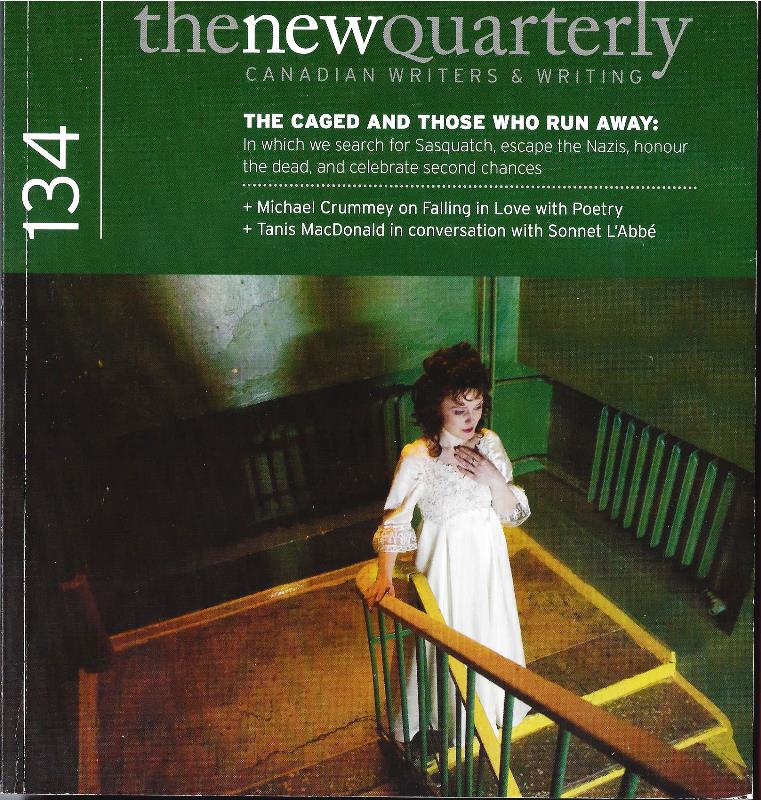
The Gulag can be regarded as the quintessential expression of modern
Russian society. This vast array of punishment zones across Russia, started
in Tsarist times and ending in the Soviet era, left a legacy on the Russian
quest for identity. In Russia, prison is usually referred to as the malinkaya
zone (small zone). The Russians have an expression for freedom: bolshaya
zona, (big zone). The distinction being that one is slightly less humane than
the other. But which one? A Russian friend once said, "First they make you
work in the factory, then they finish you off in prison." By the 1950s, the
Gulag played an integral role in the development of the Soviet economy. In
fact, Stalin used these camps as a source of economic stimulation, to excavate
the vast natural resources of the east and to stimulate growth and settlement
across the twelve time zones of the former USSR. The majority of mines, timber
industries, factories, and Russia's prized oil and gas fields were all discovered
through convict labour. In effect, almost every imaginable industry in Russia
today exists because of Stalin's policy. This photo was taken at the state
theatre in Vorkuta, a large city in the far north of Russia, beyond the Arctic
Circle, and one of the largest penal colonies created by the Soviet bureaucracy.
Today, survivors-both prisoner and guard-and their descendants still live
in this city. The woman was the lead in a play by Ostrovsky: Crazy Money.
www.donaldweber.com
Spring 2015
THE NEW QUARTERLY
Nếu không có cú dậy cho VC một bài học, là lũ Ngụy "vẫn sống ở Trại
Tù", cùng với con cái của chúng.
“Nature,” he wrote, “knows no political
boundaries.”
Thiên nhiên, Hítler phán, đếch biết đến cái gọi là biên cương chính
trị.
Lò Thiêu mắc mớ gì tới Mít?
Snyder begins the new book with an unorthodox and provocative account
of Hitler’s thinking. He stresses two arresting elements: Hitler’s skepticism
about using agricultural science for increased food production and (usefully
discomfiting for an American readership) his dependence on an American
model of development. Hitler, Snyder tells us, was obsessed with the question
of growing enough grain to feed the German population and, for various
crackpot reasons, didn’t believe that modern agronomy could make it happen
on native soil. He saw himself doing in Eastern Europe, and in Ukraine
especially, what Americans had done in the Great Plains: extinguish
or exile the natives while taking over the land to feed the metropolis.
Lebensraum meant “living space,” but in a different
sense from the way we normally understand it: a place to grow grain rather
than a place to put Germans.
Snyder’s Hitler was not exactly convinced that the Germans were a
superior race. He was convinced that they might become a superior race,
given their bloodlines and their numbers, but they would have to prove
it in competition with other races on the world stage. Startling as it
is, this view explains many aspects of Hitler’s character: his physical
distance from the ideal he espoused (they aren’t like me, but I will midwife
a superior race that I do not belong to); his unappeasable appetite for
war; his rage at his compatriots for losing his war; his readiness, at
the end, to see German land destroyed, German cities burned, German women
raped—his manifest desire for a bonfire of the Germans. He had given them
every chance to show themselves a superior race, and, since they had failed
the test of history, they must suffer the consequences.
Snyder’s Hitler is no doubt made more neatly uniform in purpose than
he really was. Revolutionary ideas tend to be rigorous: if you are plotting
a socialist utopia, a blueprint, however unreal, is called for. Reactionary
ideas, forged in rage, tend to be emotive and incoherent. We miss their
appeal if we search them for regularities they don’t possess. It takes a
purpose to illuminate a plan; it takes only one high passion to set fire
to many more.
As Snyder moves toward the specifics of the German invasion of the
Soviet Union, in 1941, he reveals again that, while no apologist for the
indigenous murderers, he is, certainly, a partisan of the peoples of Eastern
Europe. He hates the way that the Ukrainians, the Latvians, and the Poles
have been made into peasant demons, with Western sages nodding and saying,
well, the Nazis “unleashed the old hatreds.” He writes:
It is tempting to imagine that a simple idea in the minds of simple
people decades past and thousands of miles away can explain a complex event.
The notion that local east European antisemitism killed the Jews of eastern
Europe confers upon others a sense of superiority akin to that the Nazis
once felt. These people are quite primitive, we can allow ourselves to think.
Not only does this account fail as an explanation of the Holocaust; its racism
prevents us from considering the possibility that not only Germans and
Jews but also local peoples were individual human agents with complex goals
that were reflected in politics.
Ukrainians may have massacred their Jewish neighbors. But this was
not because the Ukrainians had always hated Jews; it was because the famine
of the thirties had led the Ukrainian people to fear Soviet power, and the
Nazi invocation of Judeobolshevism as the cause of their miseries provided
a pat and plausible enemy. (The Soviet administration did employ Jews “disproportionately
to their numbers,” Snyder observes, although most Soviet collaborators weren’t
Jewish.) Some did terrible things, but they did them out of political desperation
and misrouted nationalism, not enduring hate.
ebensraum meant “living space,”
"Living space" means: Đàng Trong?
The
second world war
Roosevelt’s
failure
America
could have done more to stop the Holocaust
1944: FDR and the Year that Changed
History. By Jay Winik. Simon & Schuster; 512 pages; $35
and £25.
CHRONICLING someone’s life can be tedious. The author must
plough through a mass of detail before getting to the real action. Jay
Winik, by contrast, dives straight in with “1944”, his animated tale of
how the Holocaust tragically shifted into highest gear, even as the Allies
turned the tide in the second world war.
The story begins with the Tehran conference in late 1943, when
the three main Allied leaders agreed to open a second front, in Europe. Mr
Winik, a talented storyteller, serves up memorable glimpses of the negotiations.
President Franklin Roosevelt enjoyed mixing the drinks and poking fun at
Winston Churchill, while Josef Stalin chain-smoked and doodled wolves’
heads. Just over six months after the conference came D-Day, the Allied
invasion of Normandy.
But Mr Winik’s chief focus is the Holocaust. For the Nazis’
killing machine, 1944 was a critical year. Hundreds of thousands of Hungarian
Jews boarded trains that carried them to their deaths at Auschwitz. At
the height of the terror some 24,000 Jews a day were gassed in what Mr Winik
describes as the “largest single mass murder in human history”.
The author argues that Roosevelt, whose health was waning and
who was concentrating on winning the war and forging the peace, should still
have tried much harder to stop Hitler. The contrast he draws is with Abraham
Lincoln. Whereas Lincoln signed the Emancipation Proclamation and freed
the slaves even as war raged, FDR did not make saving the Jews a priority,
despite mounting reports of genocide. The obtuseness of key officials at
the State Department set the tone for America’s tepid response. When Roosevelt
finally set up a War Refugee Board in 1944, to resettle and save Jews
and other Nazi targets where it could, it was almost too late.
This is not a heavyweight history. It skims lightly across
familiar, sometimes oversimplified terrain. Only briefly mentioned are
the bloody battles of the Pacific theatre or the furious effort to develop
the atom bomb. Instead Mr Winik dwells, passionately and at length, on
Americans’ lack of interest in bombing Auschwitz even after the genocide
was clear. While he is correct that America could have saved lives, he
alludes only fleetingly to latter-day analyses of how poorly an aerial
campaign would have worked in an era before most precision-guided bombs.
The Nazis also doubtless would have improvised had the gas chambers been
struck.
Erroneously, Mr Winik credits two Slovaks, Rudolf Vrba and
Alfred Wetzler, as being the first to escape Auschwitz, in 1944. In fact,
four others had made it out before then, by taking Nazi uniforms and commandeering
an SS car. The escape of Vrba and Wetzler was significant, because they
wrote a lengthy report on the death apparatus at the death camp. Unfortunately,
officials circulated it only slowly.
It is impossible to read this book without thinking about the
current crisis—the refugees fleeing terror and despotism in the Middle East
who are flooding into southern Europe. They are trying desperately to make
their way to, of all places, Germany. It is the largest such crisis since
the aftermath of the second world war. Europe and America should remember
the past, and welcome them. Seventy-plus years ago the doors were closed,
and history stands in judgment.
Levi Page
Hurbinek là 1 đứa trẻ “không đứa trẻ”,
một đứa bé của cái chết, một đứa trẻ của Lò Thiêu. Trông nó chừng ba tuổi,
chẳng ai biết 1 tí gì về nó, nó không thể nói, và không có tên; cái tên
kỳ cục là do chúng tôi gán cho nó, có lẽ, của một người đàn bà, người này
đã cắt nghĩa cái tên, bằng những âm thanh "chẳng ra làm sao" mà đứa bé, lúc
này lúc khác, thốt ra.
Đứa bé bị liệt nửa người, từ thắt lưng xuống phía dưới, chân teo lại,
khẳng khiu giống như hai cái que; nhưng hai con mắt của đứa bé, thất lạc
ở trong khuôn mặt hoang phế, tam giác, thì lại cực kỳ sống động, sống động
một cách khủng khiếp, đầy ắp đòi hỏi, xác nhận, ý chí, ham muốn đập bể,
phá vỡ tấm mồ là cái ù lỳ, đần độn của nó. Cái tiếng nói mà nó thiếu chẳng
ai bỏ công dậy, cái yêu cầu, “nói”, đó, khiến cho cái nhìn của nó trở nên
cấp bách, hung hãn, như 1 khối thuốc nổ: đây là cái nhìn thú vật, nhân bản,
ngay cả, có thể nói, trưởng thành, một phán quyết mà không ai trong chúng
ta có thể hỗ trợ, cực kỳ nặng nề với sức mạnh và niềm khắc khoải….
|
|
